- Science Experiments
- DIY Projects
- AI Learning Hub

Sense of Sight – A Few Experiments Worth Seeing
- October 5, 2018
- by ItsySparks
- Mini Scientists
In studying about our Fives Senses, we have enjoyed exploring our sense of touch , hearing , and taste . Our most recent exploration has been with our sense of sight. We rely very much on our sight to move around and see things every day. Our eyes are very complex in how they work. Home Science Tools gives a great explanation: How do our eyes work? The little dark circle in the center of each of your eyes lets light in. It is called a pupil. If you are in a dark place where no lights at all are on, can you see anything? No, you can’t because our eyes need light to be able to see! Once the light goes in, it hits a part inside at the back of your eye that is very sensitive to light. This part is called the retina. When light touches the retina, it makes an upside-down picture of whatever you are looking at. A large nerve called the optic nerve carries the image to your brain where it gets turned around so that you see it the right way instead of upside-down!
We also found a great video for kids to explain how the sense of sight works too. Click here to view . We did a few experiments to make us think about how we use our eyes every day. Our first experiment was writing with a blindfold on. He realized right away how challenging it was to write without using our sense of sight.
Next we looked at different objects. We used our sense of sight to describe the color and shape of each object. We then played a fun game where we placed all of the objects on a piece of paper. I put the blindfold over his eyes. I removed one object. Then he had to remember what he saw and tell me which object went missing.
Our last experiment was to walk slowly with our blindfold on. This was done carefully, with adult supervision, so if you decide to try this one, make sure your little one walks very slowly!
A lot of conversation came out of these experiments. We talked about how some people have impaired vision and use glasses to help see better. We talked about how some people have complete loss of vision and are blind. I explained about how blind people or partially sighted people use braille to read and write. You can read more about braille and the braille alphabet here .
Our eyes are fascinating indeed, in the way that they work. We rely on our eyes very much, and also from the very moment we wake up! They sure do a lot a lot of great things for us and help us see many wonders of life and the world – make sure to take good care of them!
1 thought on “Sense of Sight – A Few Experiments Worth Seeing”
Pingback: ItsySparks | Sense of Smell – What Scent can you Sense?
Leave a Reply Cancel reply
Your email address will not be published. Required fields are marked *
Save my name, email, and website in this browser for the next time I comment.
Join over 125,000 educators for tips & tricks in the Facebook group .
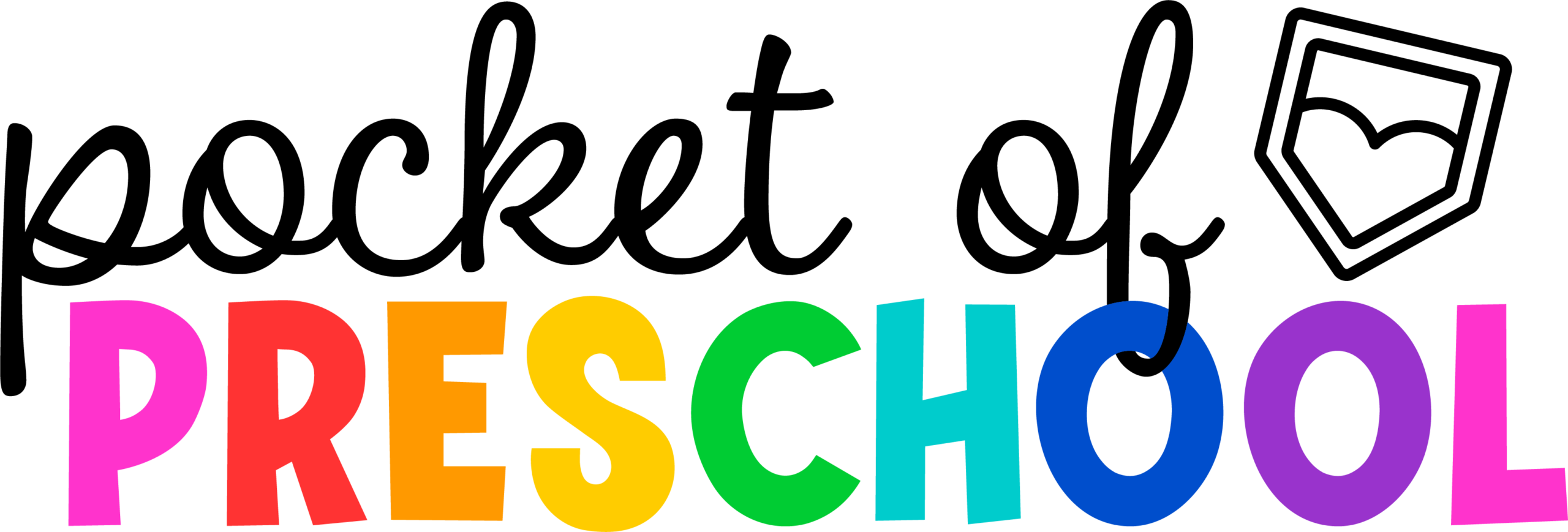
- Back to School
- Science and STEM
28 Hands-On 5 Senses Activities for Preschool, Pre-k, and Kindergarten
Share this post:.
- Share on Twitter Share on Twitter
- Share on Facebook Share on Facebook
- Share on Pinterest Share on Pinterest
- Share via Email Share via Email
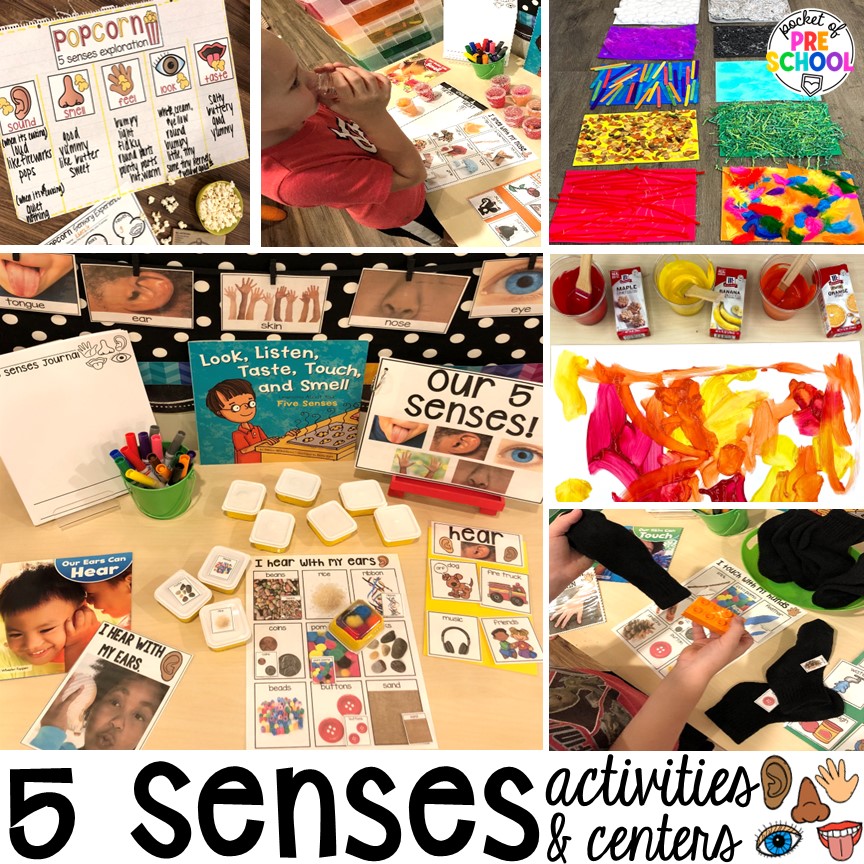
Explore these 5 senses activities to help students understand their body and learn about these important features. My little learners love learning about their senses, and these activities are designed to be hands-on, captivating, and educational for preschool, pre-k, and kindergarten students. Plus, I have a 5 senses activities FREEBIE just for you!
Grab the 5 senses activities printables to get you started! Little Learners 5 Senses Science unit & Gingerbread 5 Senses Science unit for a fun holiday twist!
Grab the FREE 5 senses printable at the bottom of the post to kickstart your 5 senses activities!
This post contains affiliate links, which means I earn a tiny commission when you use my links at no cost to you.
5 Senses Activities Freebie
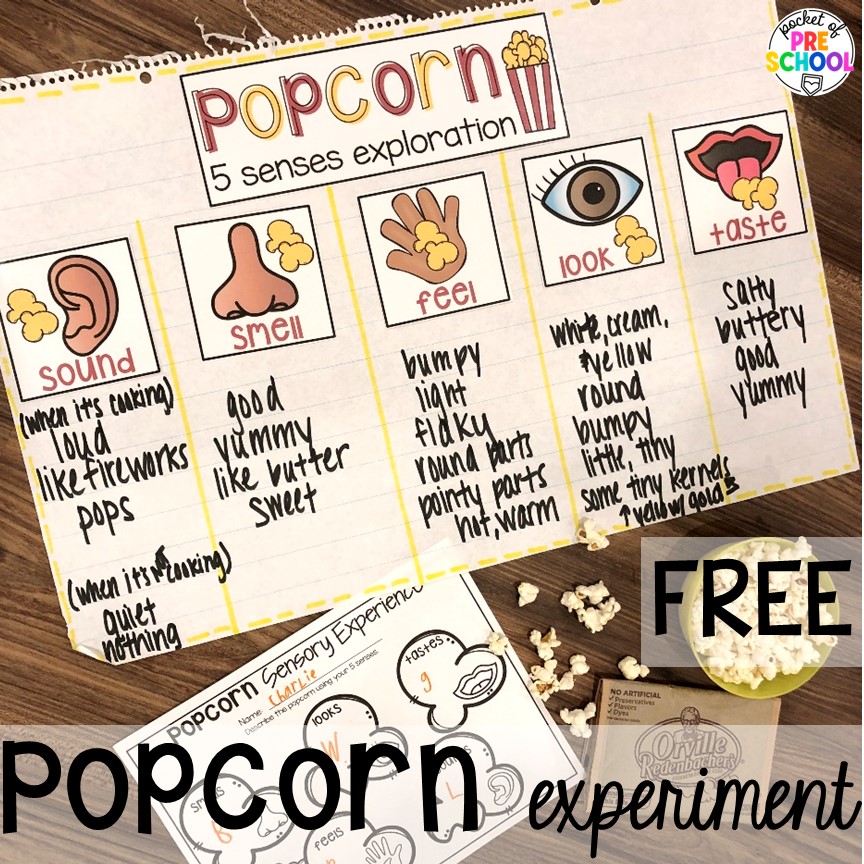
Popcorn Experiment! Introduce your 5 senses unit with a popcorn experiment! Kids love popcorn, and it hits all the senses in this fun, interactive experiment. Students taste, touch, smell, see, and hear the popcorn while learning about their 5 senses. This could also be a great way to end your 5 senses unit for a hands-on recap.
>>Grab the 5 senses FREEBIE by filling in your email in the box at the bottom of this post, and it will be sent to you!<<
5 Senses Activities for Touch
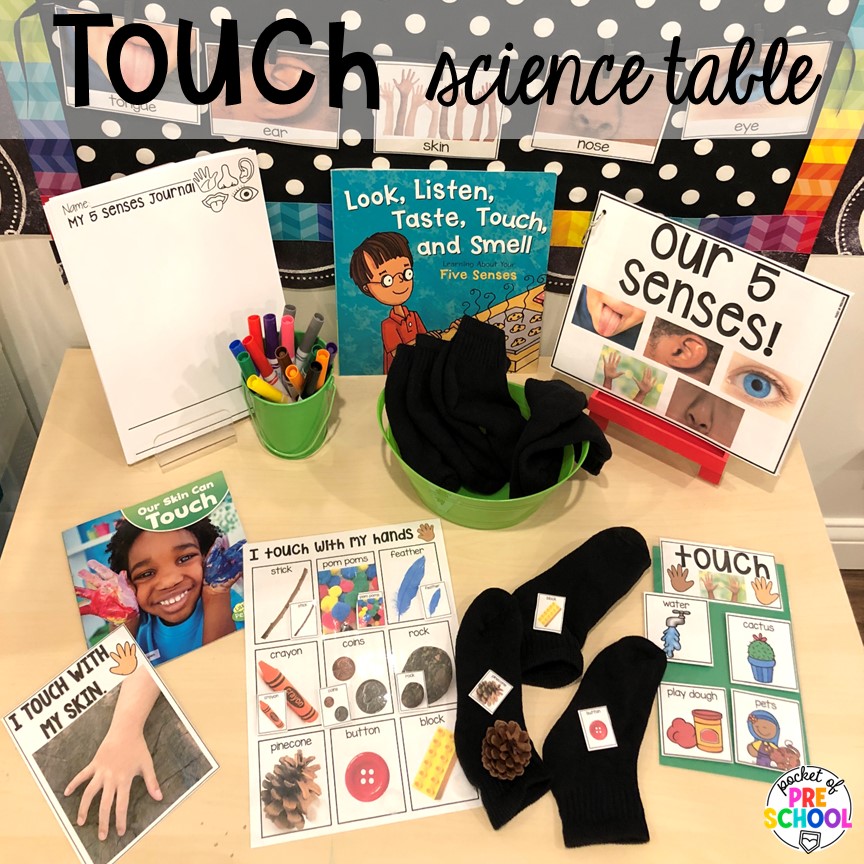
Touch Science Table ! Set up a touch science table to allow your young children to explore their sense of feeling or touch. I have books, journal papers, and a few hands-on sorting games they can play.
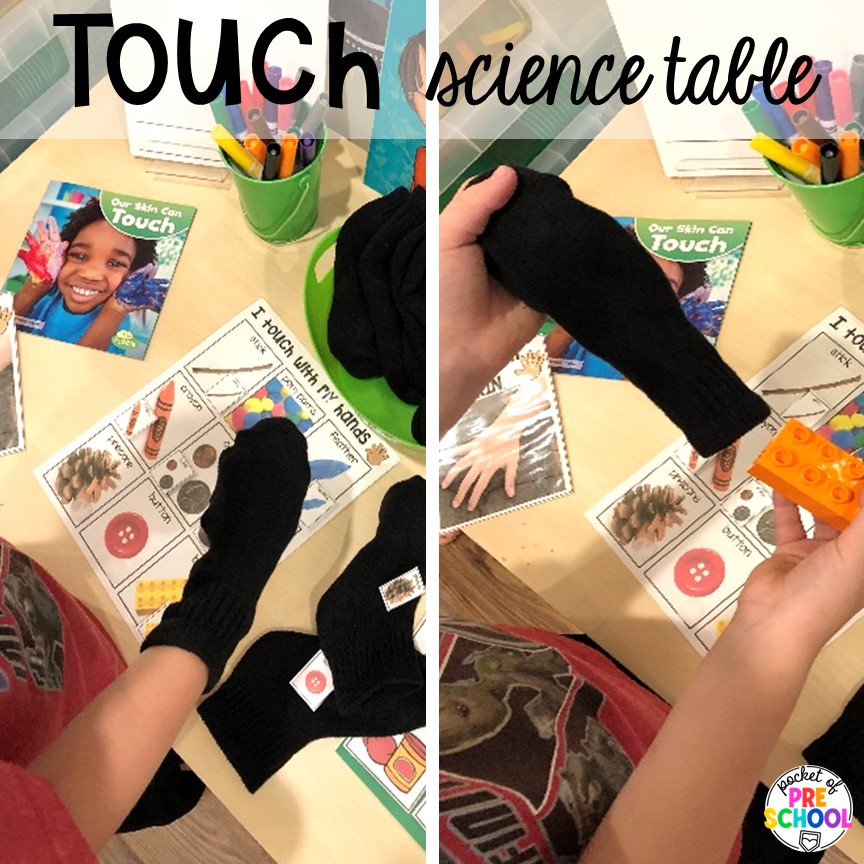
I hide things in black socks so they can’t see it. Then, they stick their hands in and try to guess what is inside without looking. My students love these touch games! Plus, they are developing fine motor skills while learning about the sense of touch.
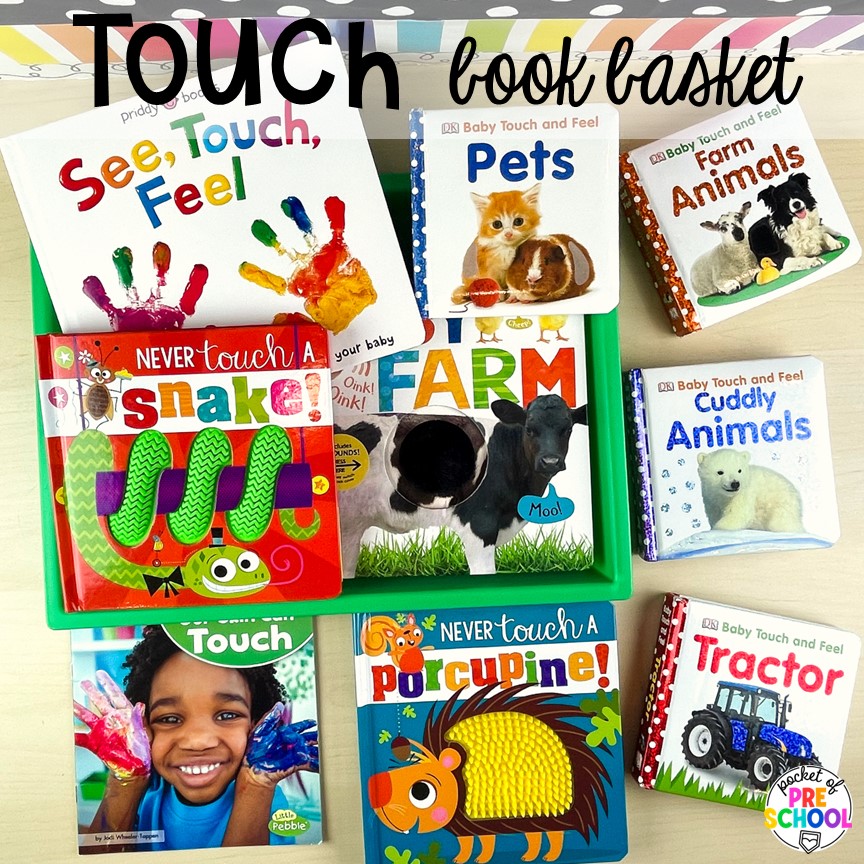
Touch Book Basket! Also, on my touch science table is a basket of books perfect for touching! These titles feature areas to touch and feel with tons of different textures and materials. The Never Touch a … titles are a great addition to a senses book basket.
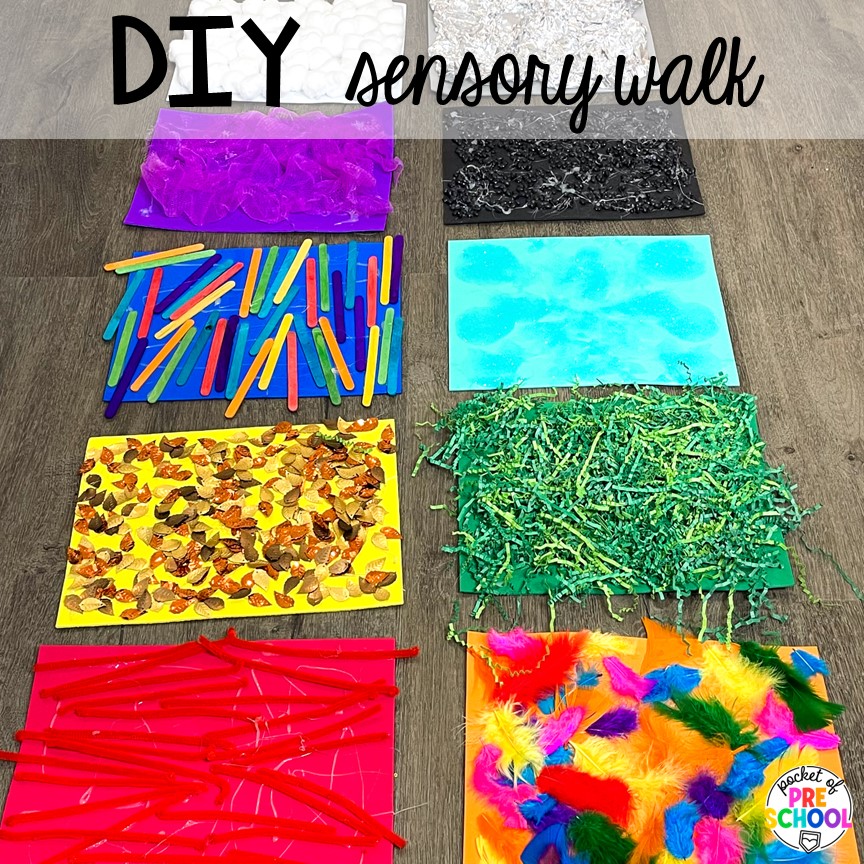
DIY Sensory Walk! Create your own sensory walk for science time or use it during indoor recess or gross motor time. I glued different textures and materials to pieces of cardstock. Students took their shoes and socks off and walked across the pages. They were able to feel all the different textures with their feet.
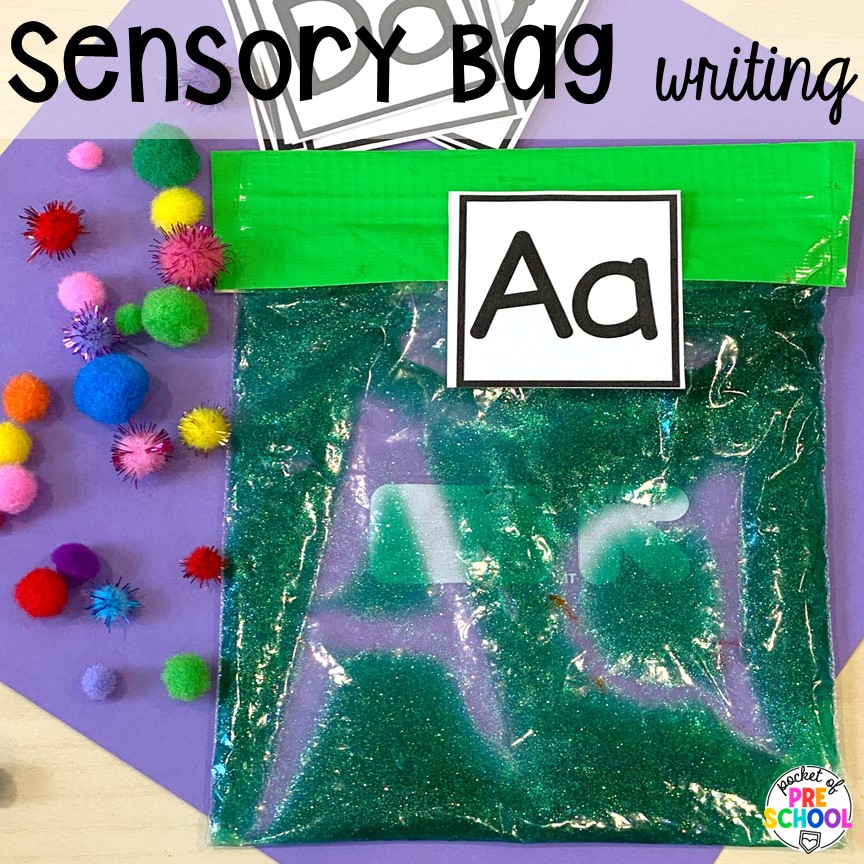
Sensory Bag Writing! To give students another touch opportunity, we practice writing on a sensory bag. This is a hair gel bag with glitter and a little bit of liquid watercolor mixed inside. Students can use their fingers or a pom pom to write letters, numbers, words, etc. Click here to get step-by-step directions for making a sensory bag.
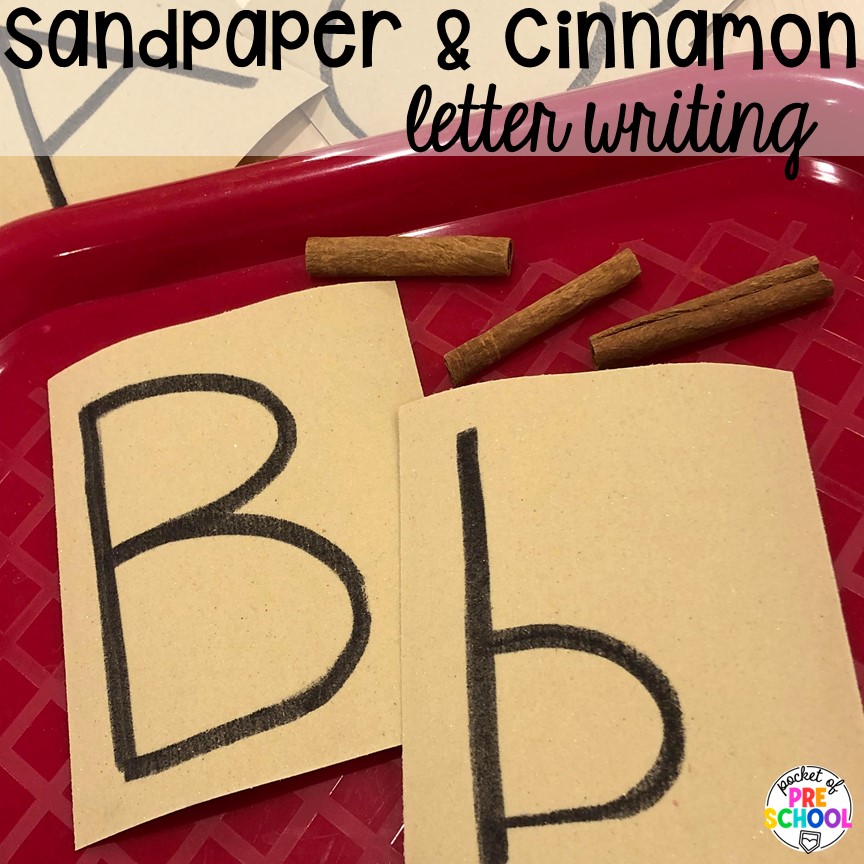
Sandpaper and Cinnamon Writing! I love these 5 senses activities for writing! Grab some sandpaper and cinnamon sticks to make your own letter sheets. Write the letters or numbers on the sandpaper. Then, students can use their fingers to trace the letters. For even more sensory, give them a cinnamon stick to trace the letter with. This not only gives them a chance to learn about touch but also smell! Plus, your room will smell amazing when they are done!
5 Senses Activities for Smell
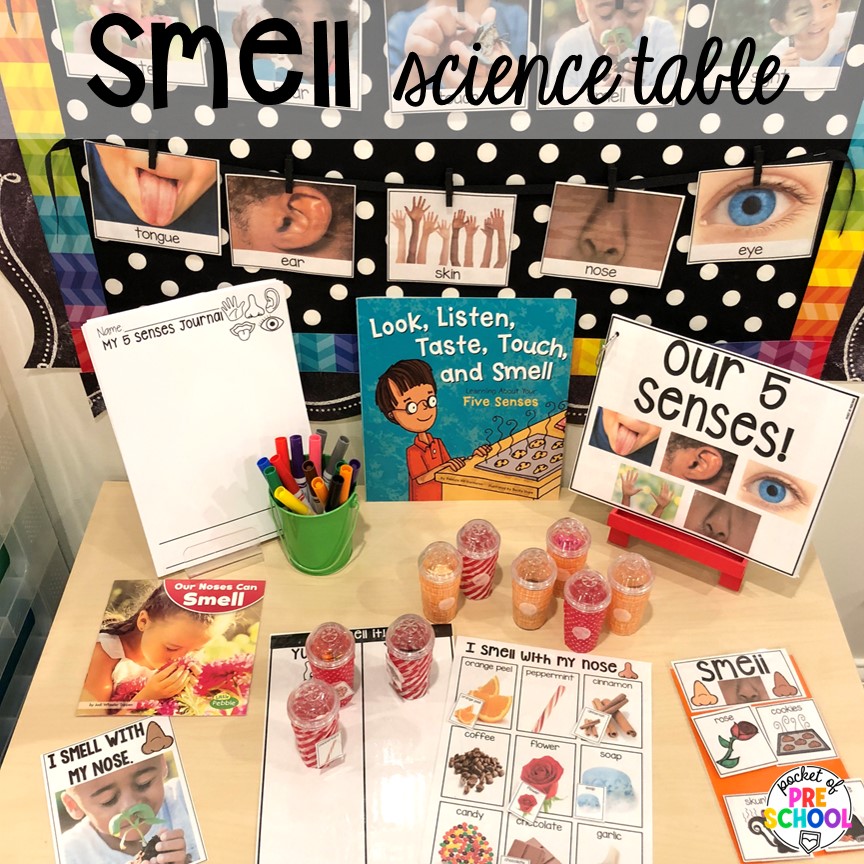
Smell Science Table ! Check out my science table all about the sense of smell. There are books, journal pages, smell sorts, and a smelling exploration. Your young children will love the matching smell game. The science table is a great place to give students more opportunities for social interaction, sensory activities, and help develop problem-solving skills.
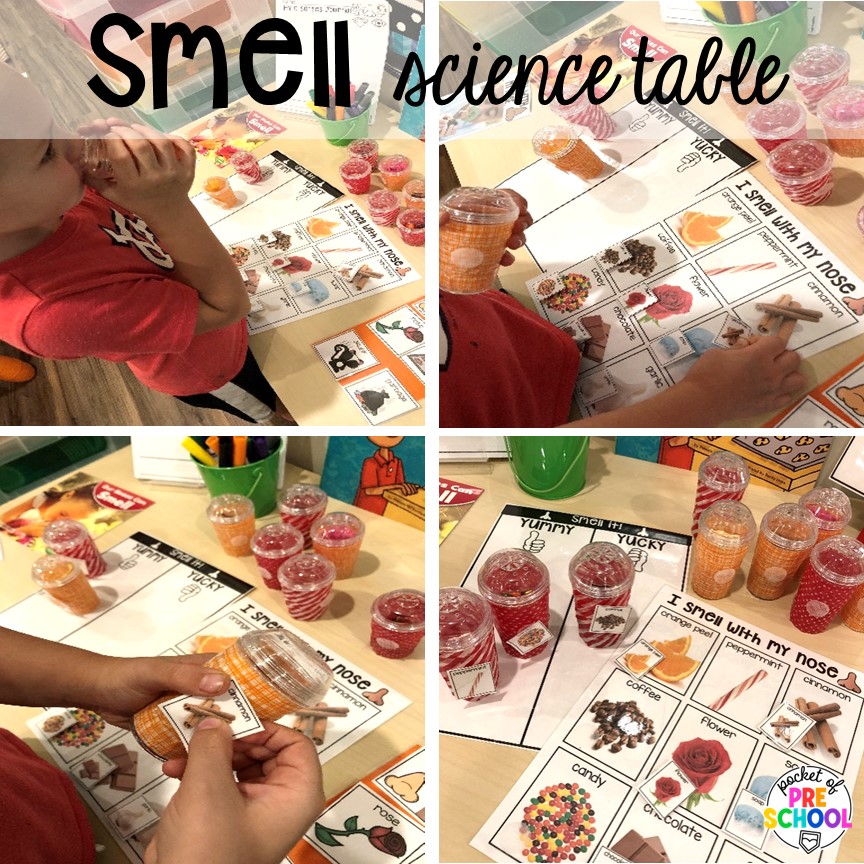
I place smelly items in the salt and pepper shakers from the dollar store. I put tape around them so students can see inside as easily. This is the best way I have found to kind of hide the materials inside. Then, students smell the shakers and guess what is inside by placing a small picture on the velcro. You can also place cotton balls with different scents of essential oils on them inside the shakers.
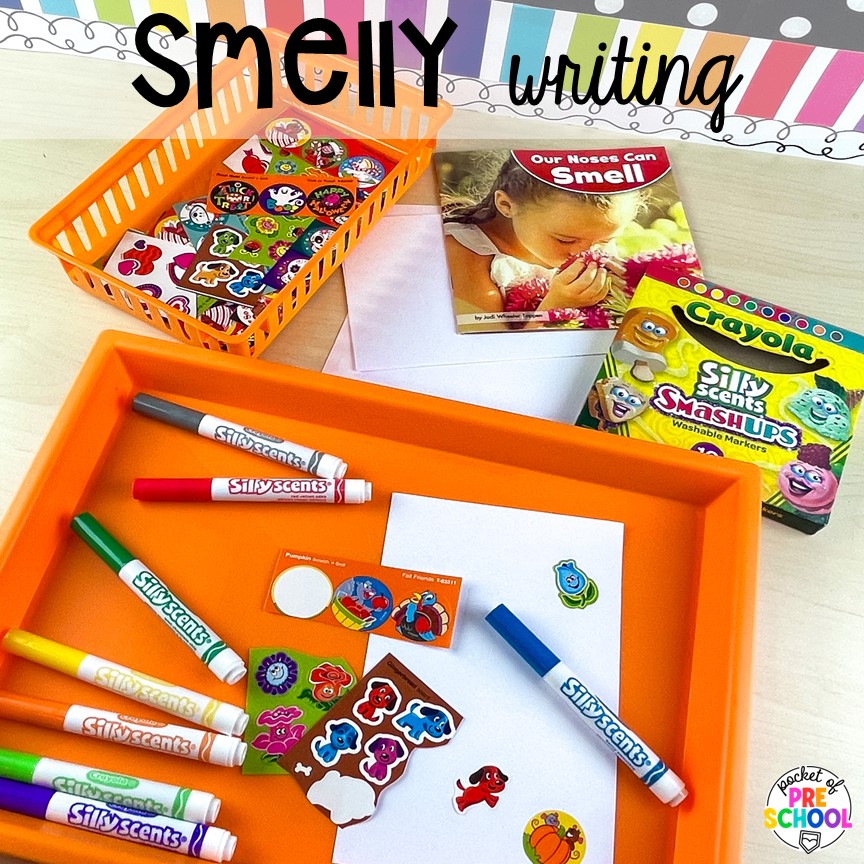
Smelly Writing! For an easy smell center for 5 senses activities, grab some smelly markers and paper. Students can explore the scents while writing and drawing in the classroom.
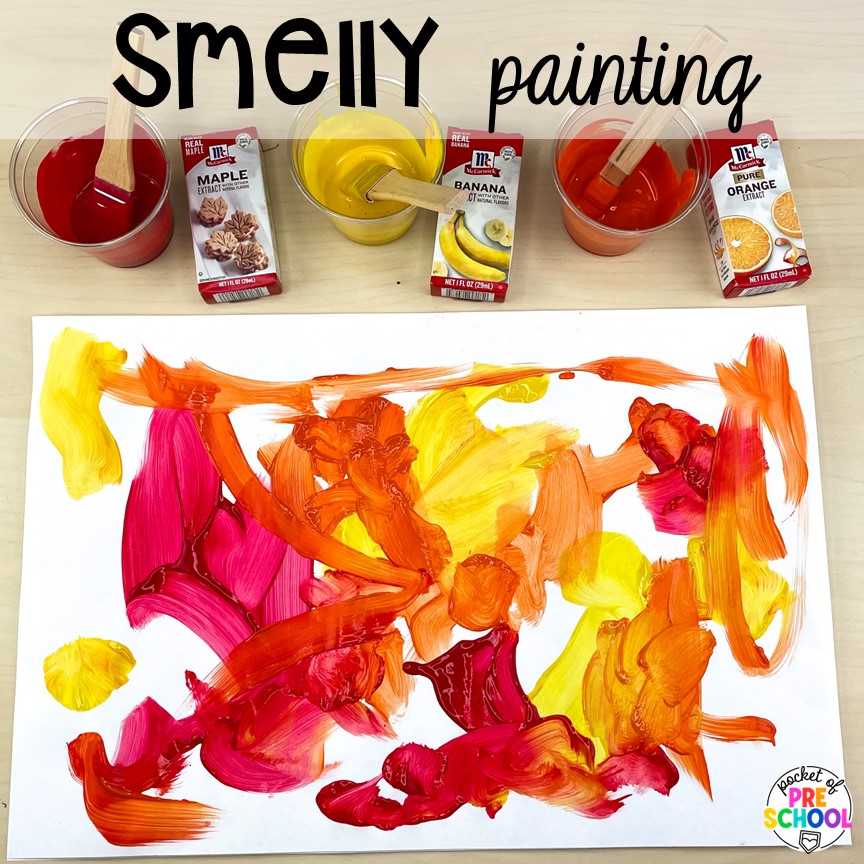
Smelly Painting! Create a smelly painting by mixing your paint with liquid extracts from the cooking aisle. I made maple, banana, and orange paints so that they were scents that my students would recognize.
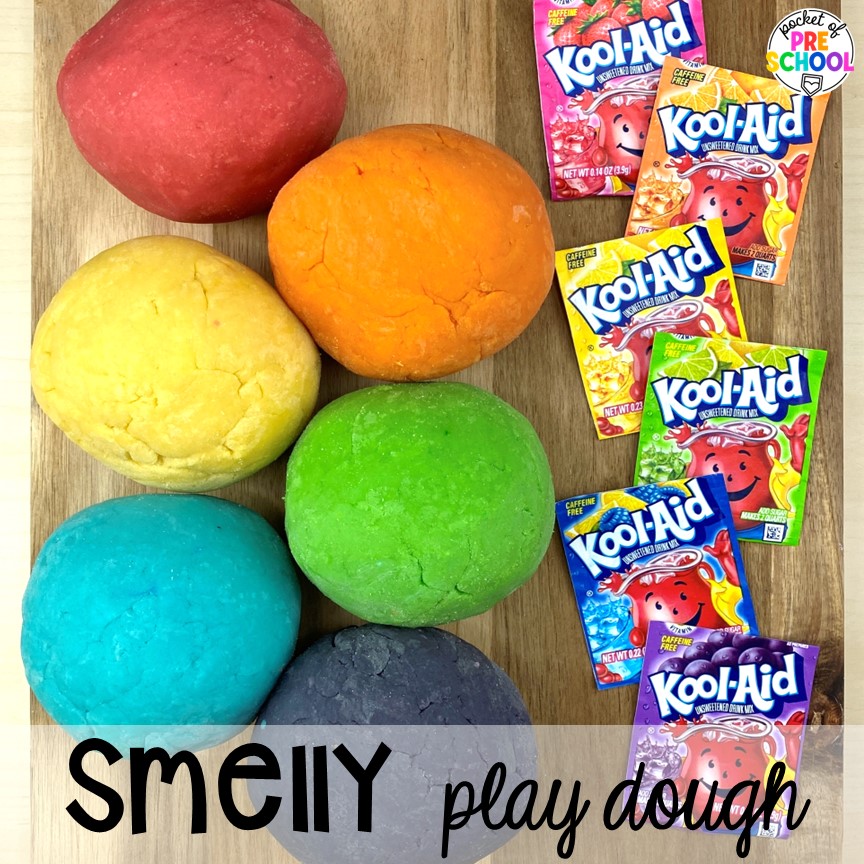
Smelly Play Dough! Add Kool-Aid powder to your homemade play dough to make it smelly! I also added liquid watercolor to make the colors more vibrant! If you are learning about the 5 senses during the holidays, I like to add cinnamon to my homemade play dough. My students love the different smells, and this makes great multi sensory experiences for your students.
5 Senses Activities for Hearing
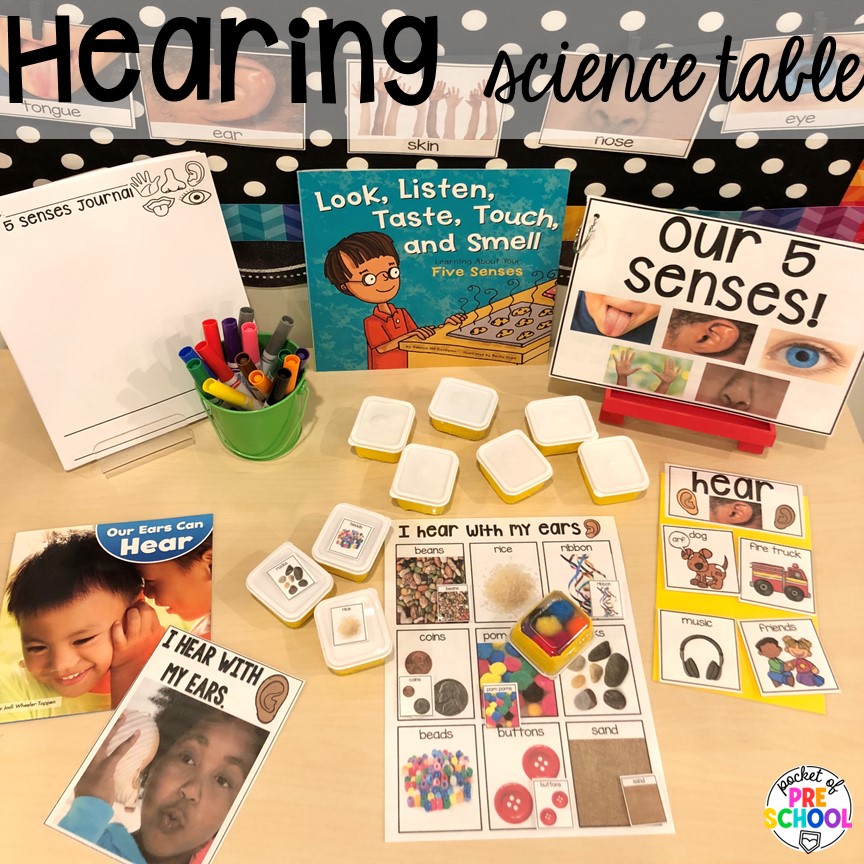
Hearing Science Table ! Set up a science table all about the sense of hearing. I like to have books, journal papers, hearing sort, and a hearing activity.
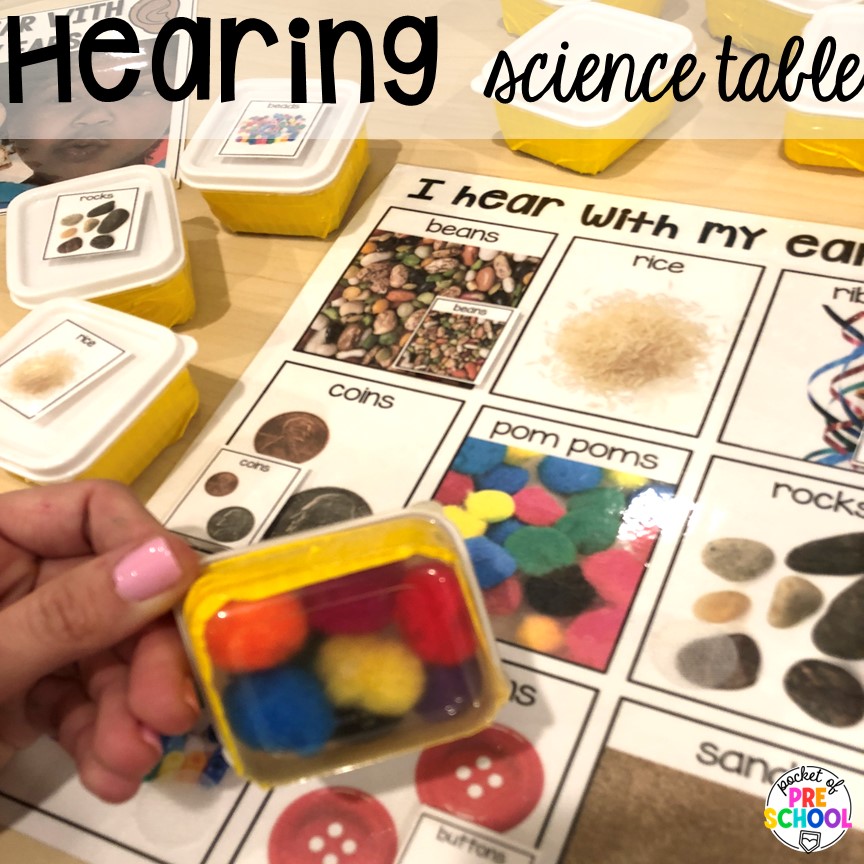
Create a hearing exploration with some small containers filled with a variety of objects that sound differently when shaken. I put tape around the containers so students can’t see what is inside until they flip it over to check their guesses.

Hearing Book Basket! Check out some of my favorite hearing books that I use in my preschool room. These sound books are perfect for exposing students to a variety of sounds from different environments.
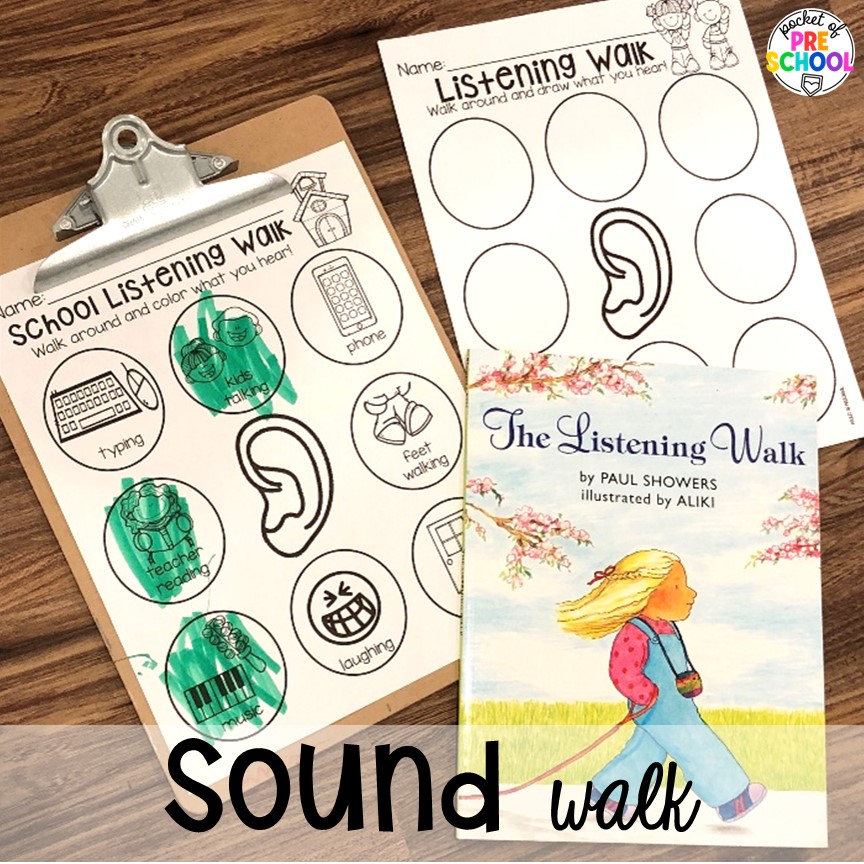
Sound Walk! Go on a sound walk around the school or outside. I like to read the book The Listening Walk . Then we go outside if the weather is nice or walk around the school building listening. Use the recording page to keep track of things that you hear.
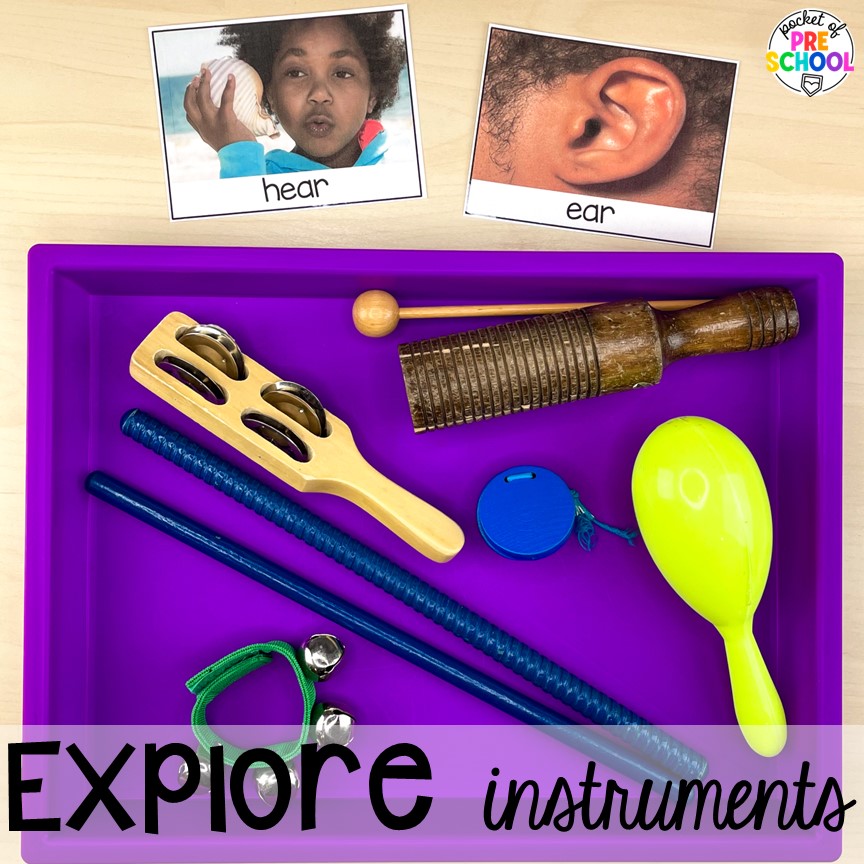
Explore Instruments! One way to explore the sense of hearing is by using musical instruments in the classroom. My students love making music while learning about the sense of hearing.
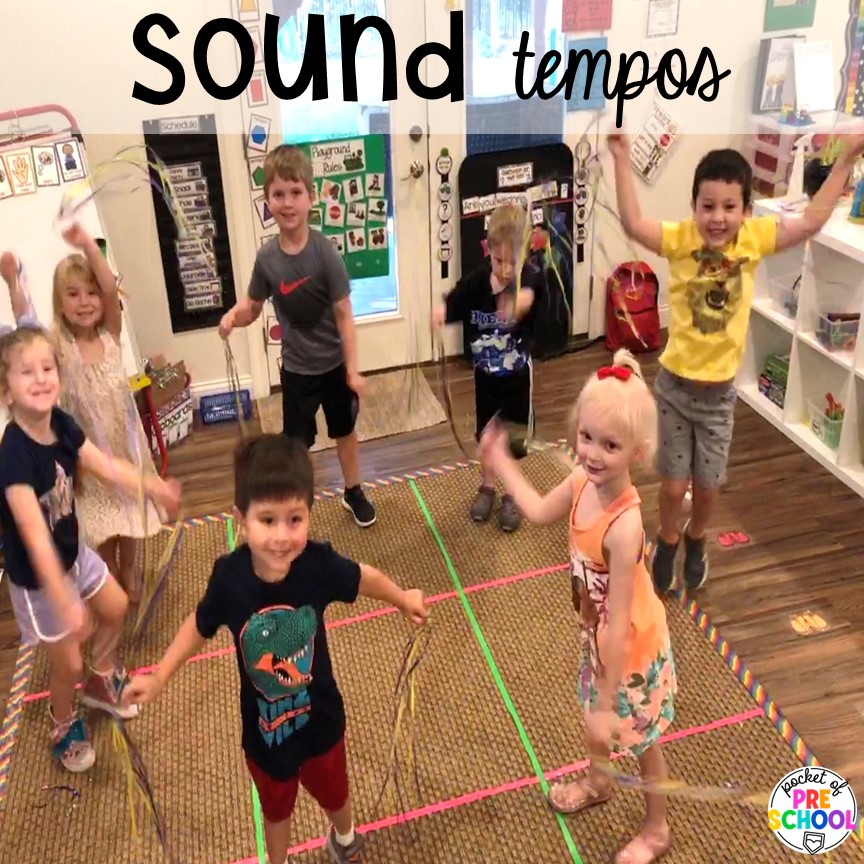
Sound Tempos! Give students a chance to get out their extra energy while they explore tempos and hearing. My students are using ribbon shakers to move and dance with. They are pieces of ribbon tied to plastic bracelets. Talk about fast and slow tempos during this activity.
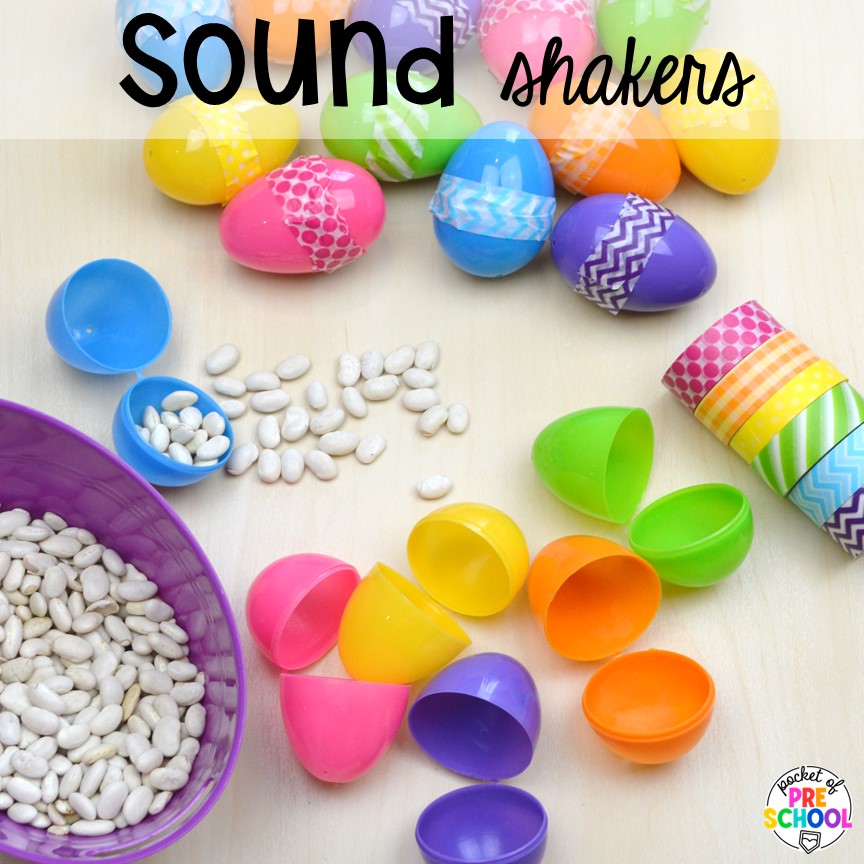
Sound Shakers! Use plastic eggs and fill them with different objects for different sounds. Then tape them shut. So easy but such a fun learning experience. I also use these during dance parties, indoor recess, and gross motor time. Your students will have a lot of fun shaking and moving with these simple egg shakers.
5 Senses Activities for Sight
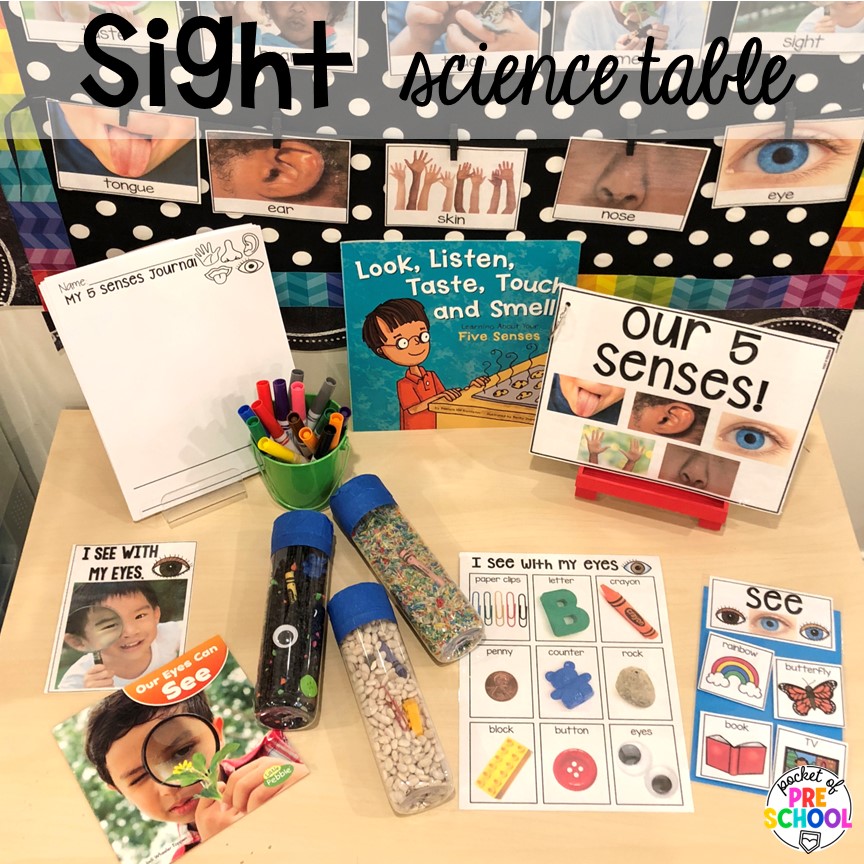
Sight Science Table! Check out my sight science table for preschool, pre-k, or kindergarten students. Lots of books, journal pages, and sight activities. My students love the I Spy bottles for a fun activity about the sense of sight.
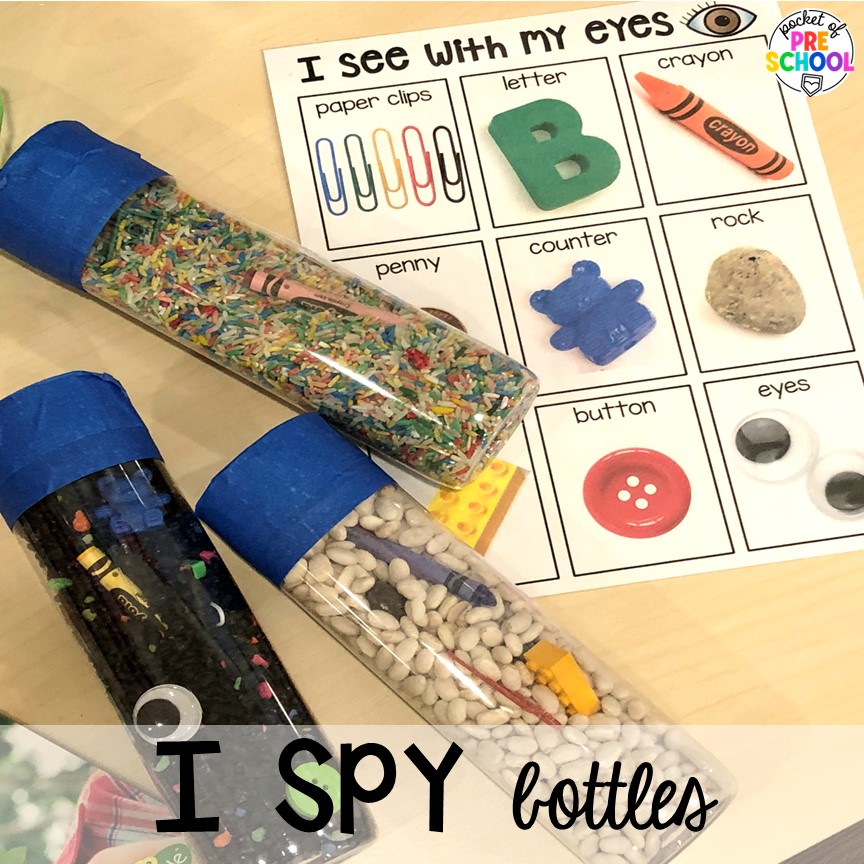
I Spy Bottles! Create I spy bottles for a fun and engaging sight activity. Students will look for objects in the bottles. I also have a bunch of sensory bottles for tons of themes throughout the year. You can find them here . You could also create these on a larger scale in sensory bins for students to touch and spy various items. That would be so much fun for kids of all ages!
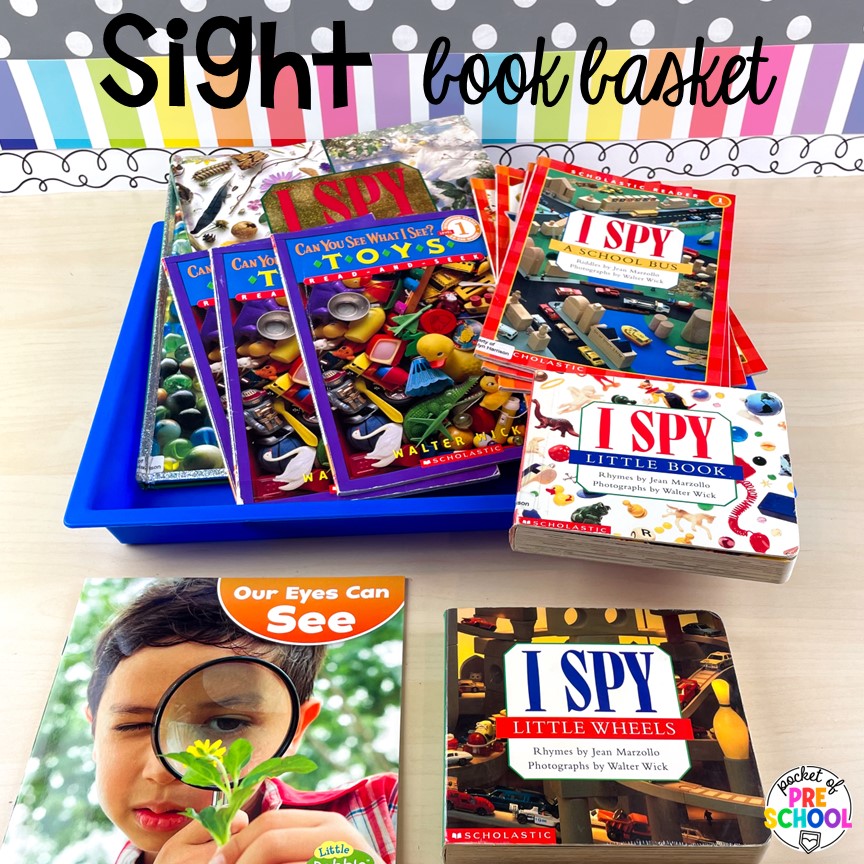
Sight Book Basket! In my book basket for sight, I love these books for preschool students. My students love I Spy books and these board ones are simple and perfect for little minds.
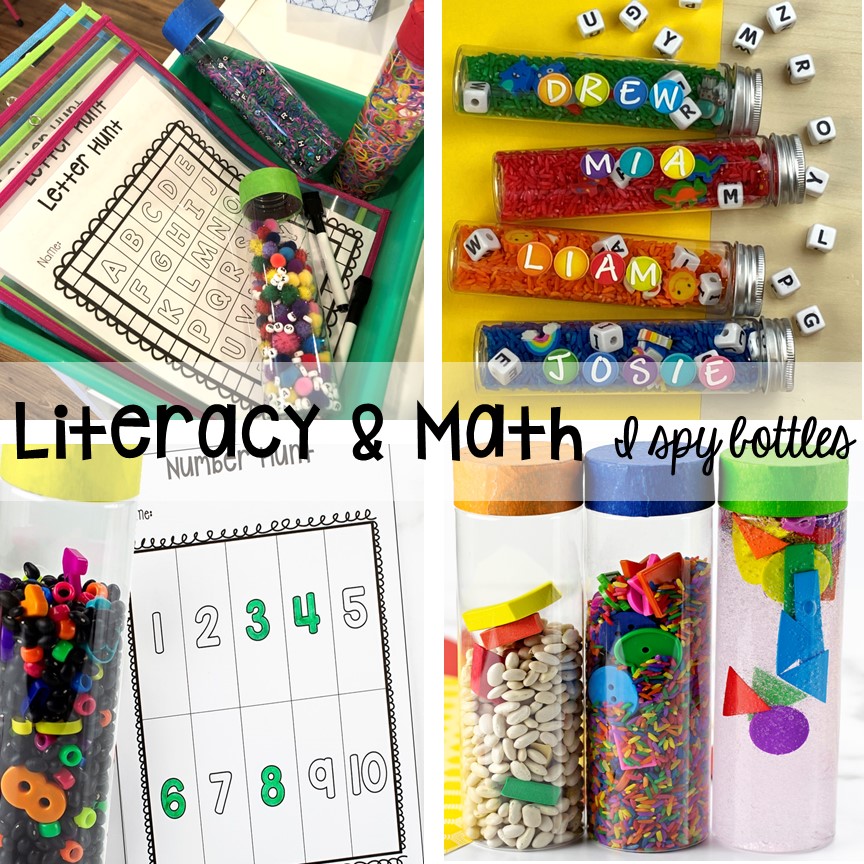
Math & Literacy I Spy Bottles! If your students love the I spy bottles like mine do, I also created math and literacy I spy bottles. I have a number, shapes, names, and letters bottle. There are also FREE worksheets that go with the bottles to guide students in what they should be looking for.
To get step-by-step directions and FREE printables for the other I spy bottles just click the words for the one you would like to make: numbers , shapes , names , and letters .
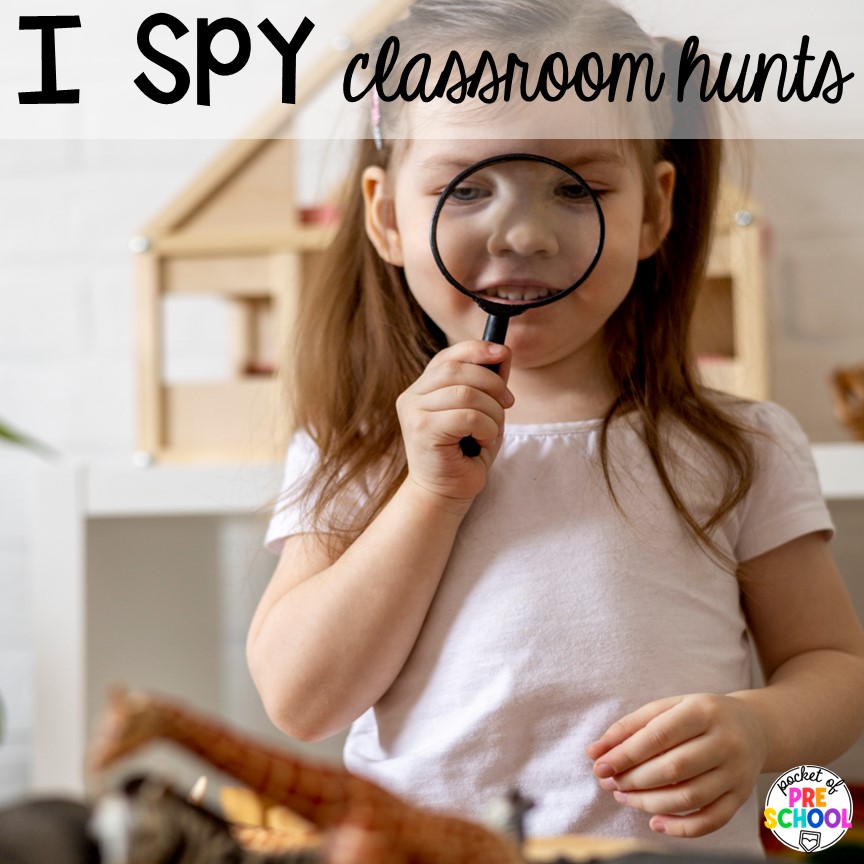
I Spy Classroom Hunts! Give your students a magnifying glass and watch them explore their environment. I like to give them a list of things to find around the room, but you could also just let them freely explore their area. If the weather is nice, go on a nature walk! Outside, you can hear various sounds, see different colors, touch various items, smell different scents, and maybe taste a thing or two.
5 Senses Activities for Taste
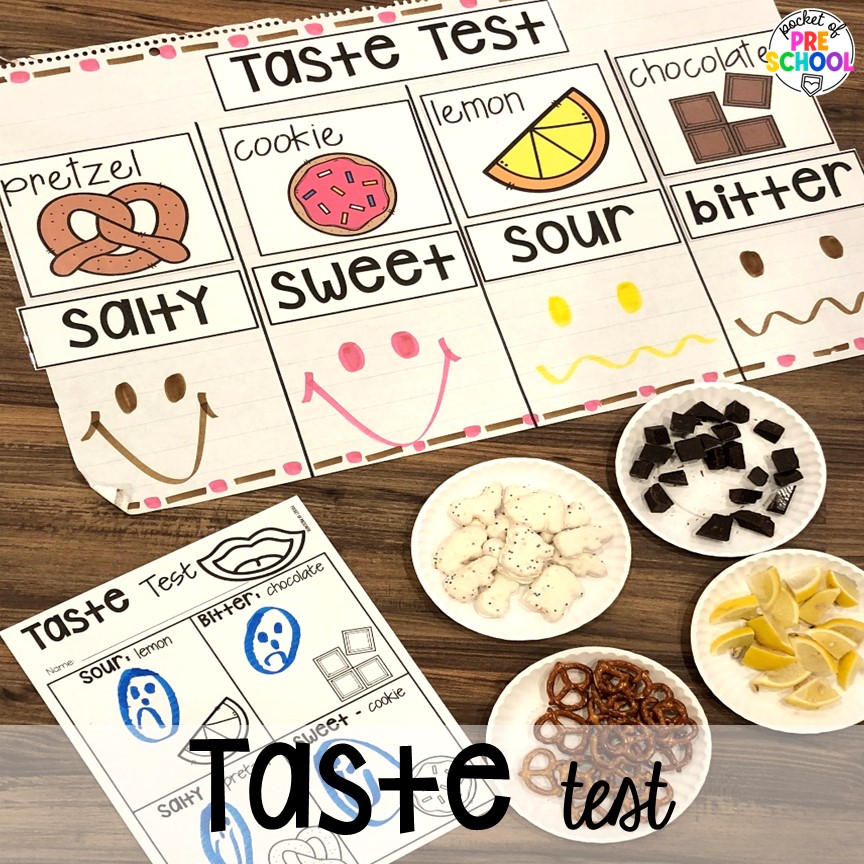
Taste Test ! Explore the sense of taste with a fun taste test in the classroom. I use pretzels, lemons, cookies, and dark chocolate for my taste test. Grab the printables for this fun exploration here . We do this as a whole class activity for students to practice making inferences, gather data, and describe results. We also talk about our taste buds.
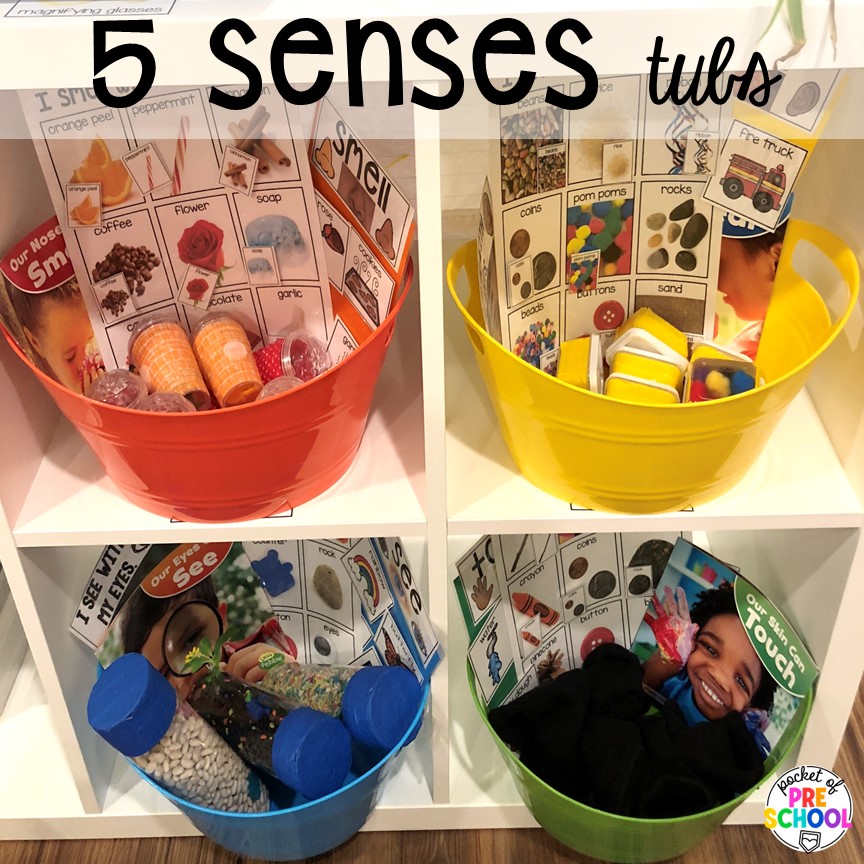
5 Senses Tubs! If your classroom is small, you can make a tub for each sense to have for your students. When we talk about each one, I show them everything in the tub, and then they can get things out during center time. If there is a tub that is very popular, I will leave it out for longer than the unit until they become bored with it.
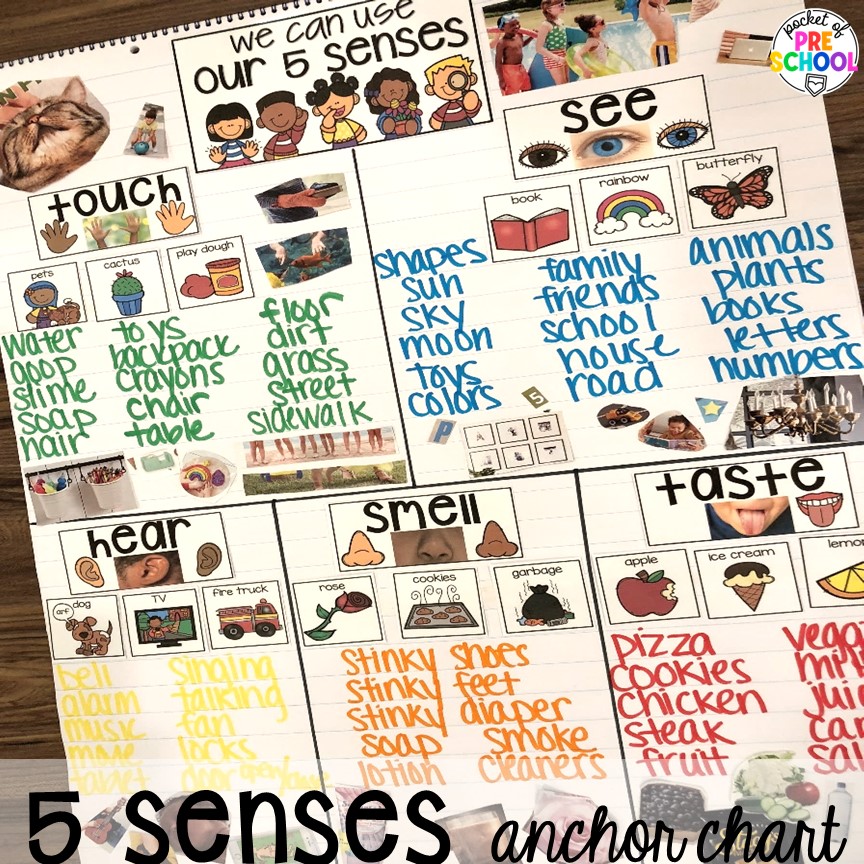
5 Senses Anchor Chart ! Create this anchor chart with your students for interactive 5 senses activities that teach. Use the anchor chart printables to get started and then help students add more ideas.
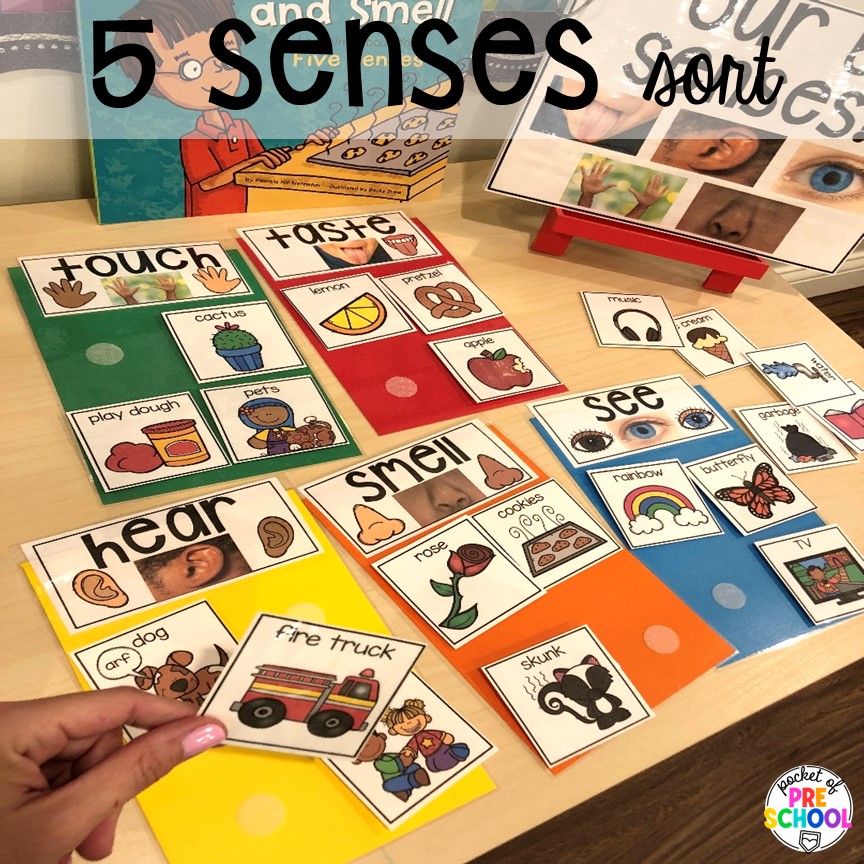
5 Senses Sort ! Give students these hands-on 5 senses activities with some sorting mats. Students can look at the pictures and sort them by the sense that they will use with it.
I hope you enjoyed these 5 senses activities, and I can’t wait to see what you do in your classroom! My students love a five senses unit and learn so much. You can do it at the beginning of the year with your all about me theme or during the holidays with a gingerbread twist.
Click the pictures below to grab the 5 senses printables that you need for your lesson plans!
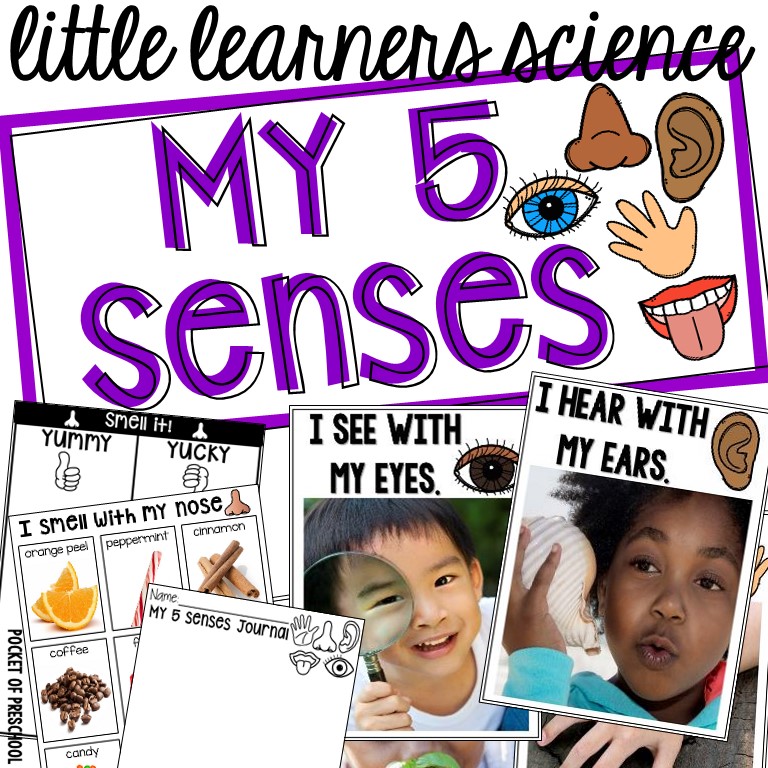
Want to see these 5 senses activities in action? Just click the picture below for a video!
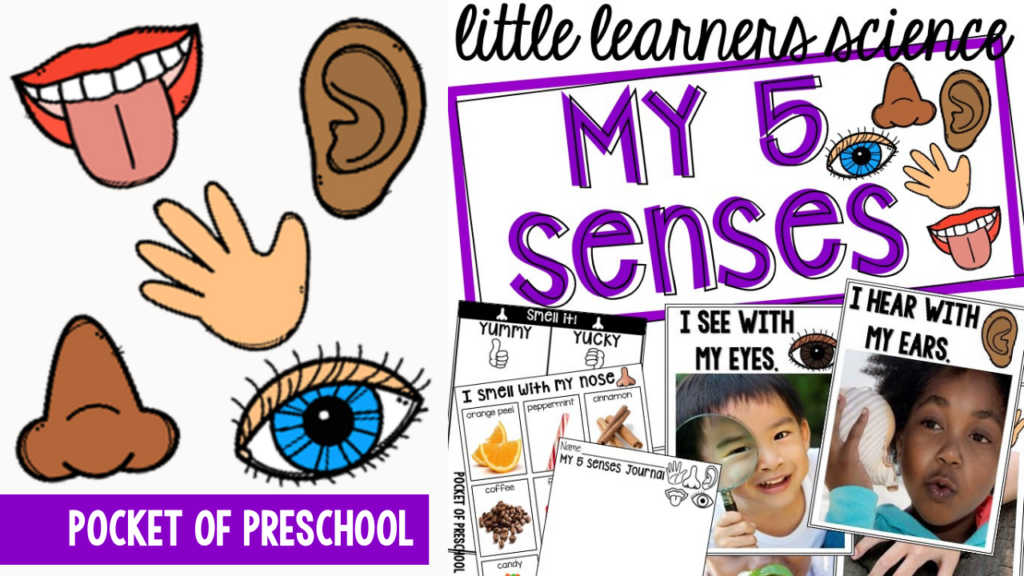
Grab the 5 senses FREEBIE by filling in the box below!
Love these 5 senses activities? Pin this image!
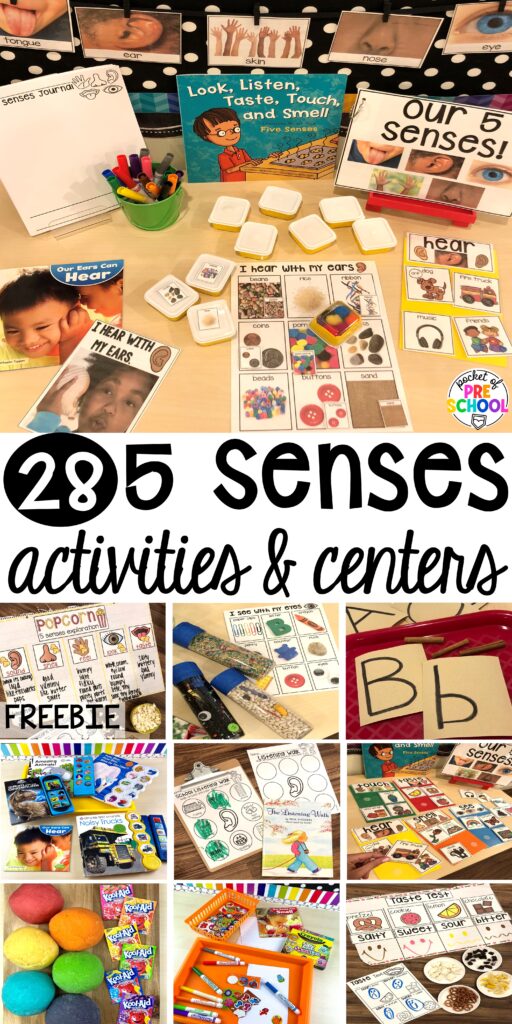
hey, i’m jackie!
I’m Jackie, your go-to girl for early childhood inspiration and research-based curriculum.
Similar Posts
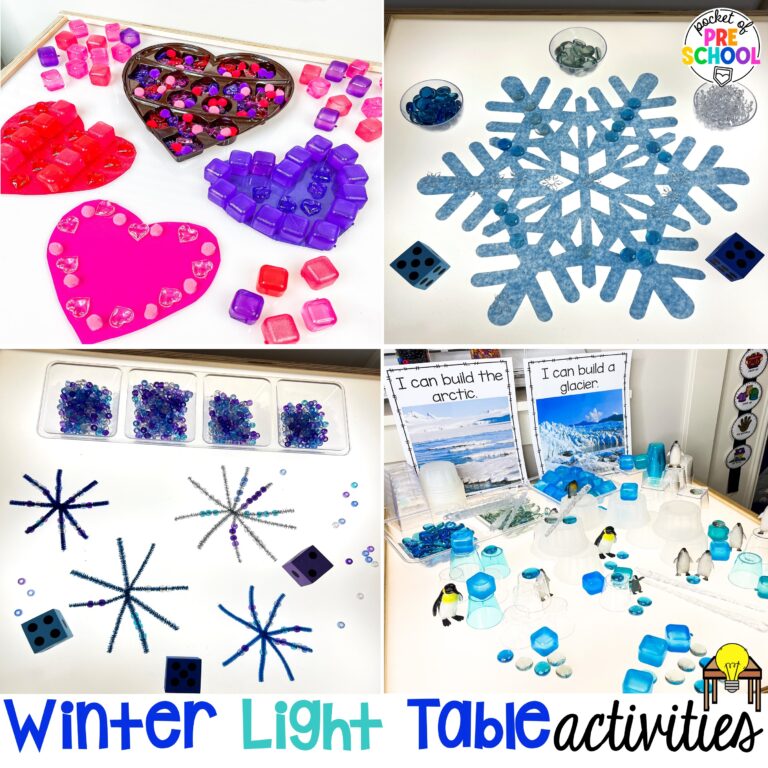
Winter Light Table Activities for Preschool, Pre-k, and Kindergarten
Explore all the things of winter with these winter light table activities for preschool, pre-k, and kindergarten students. There are winter theme ideas for literacy, math, fine motor skills, science,…
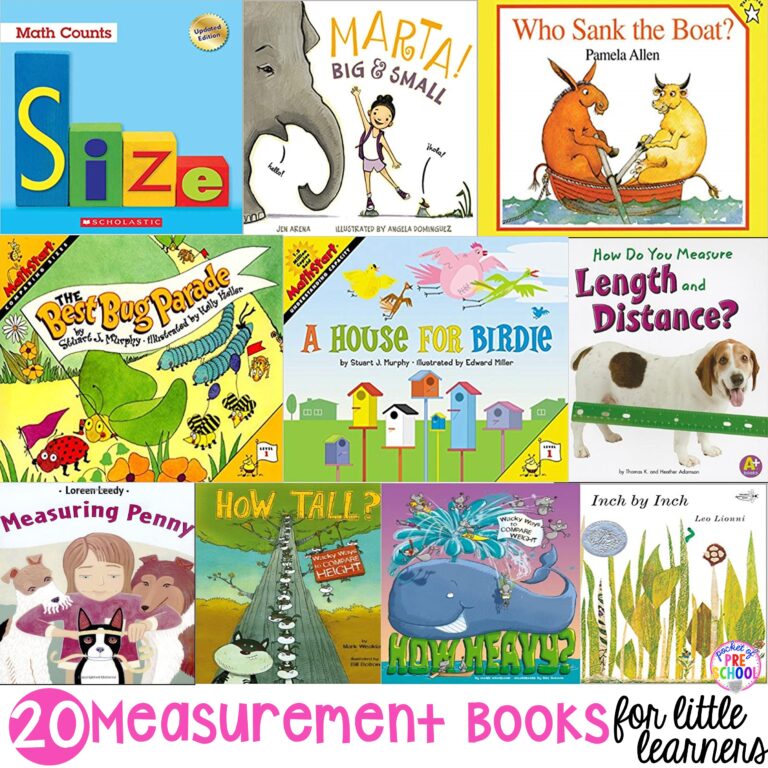
20 Measurement Book List for Little Learners
Measuring can be so much fun for little learners! This measurement book list has the perfect additions you need for your class library to engage your students in the world…
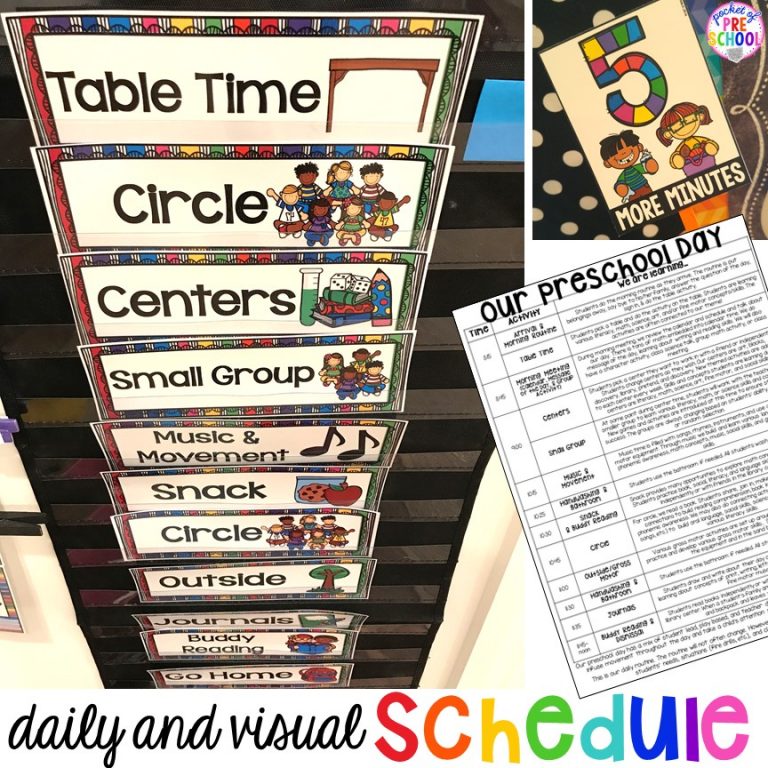
Preschool Daily Schedule and Visual Schedules
Preschool daily schedules and routines are so important for our little learners (and teachers, too). Routines help students feel safe and secure because they know what is coming next and what…
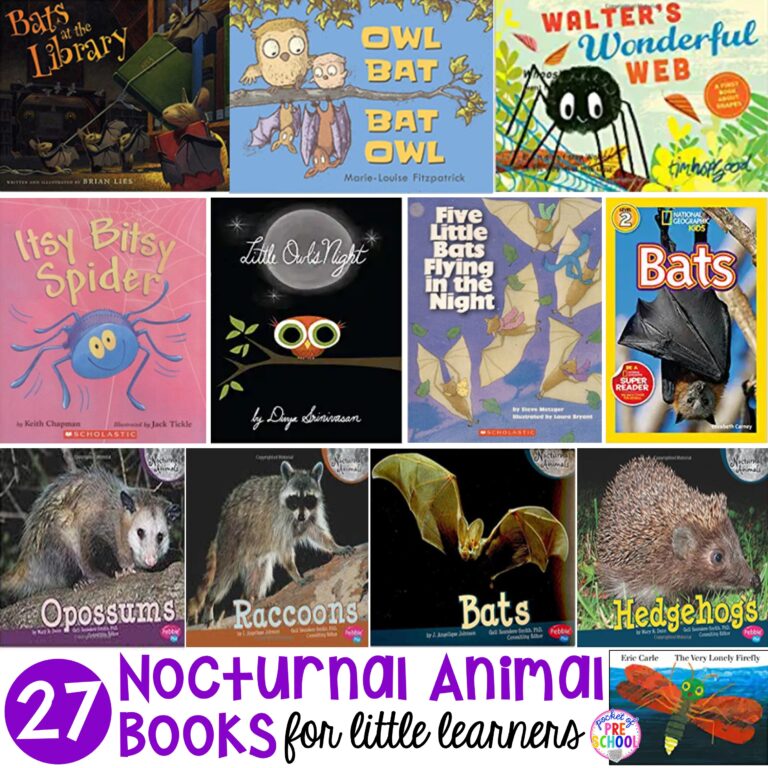
27 Nocturnal Animal Books for Little Learners
Check out my list of 27 nocturnal animal books for little learners. Bring nature into the classroom & watch your little learners transform into scientists! I created this booklist for…

Physical Science Books for Little Learners
Physical science is the study of the nonliving things in the world and states of matter. I have put together my favorite physical science books for preschool, pre-k, and kindergarten…
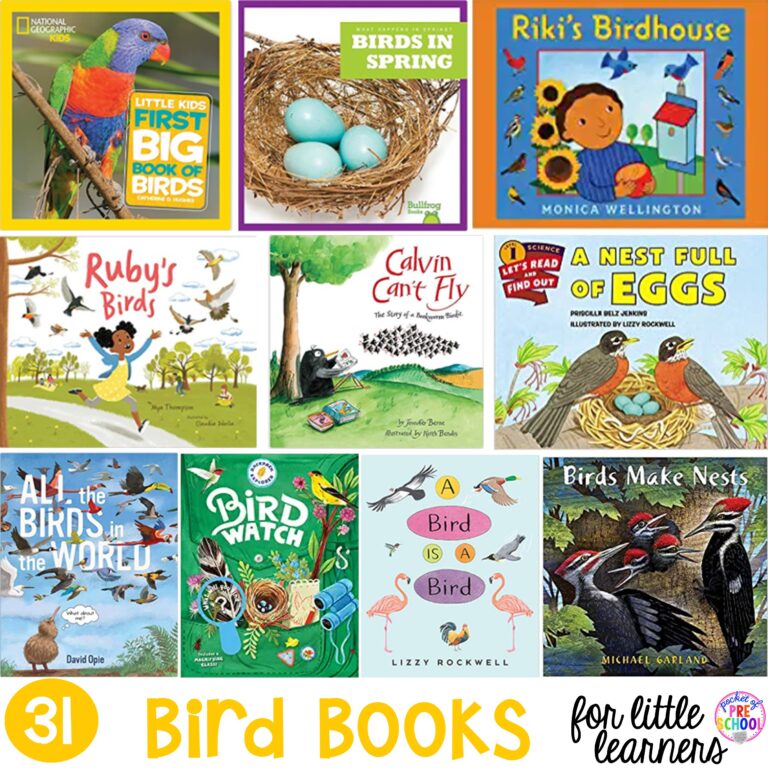
31 Bird Books for Little Learners
Check out these 31 bird books for little learners & watch your students become little scientists! They will love learning about their life in the wild. Preschool, pre-k, and kindergarten…
Follow On Instagram
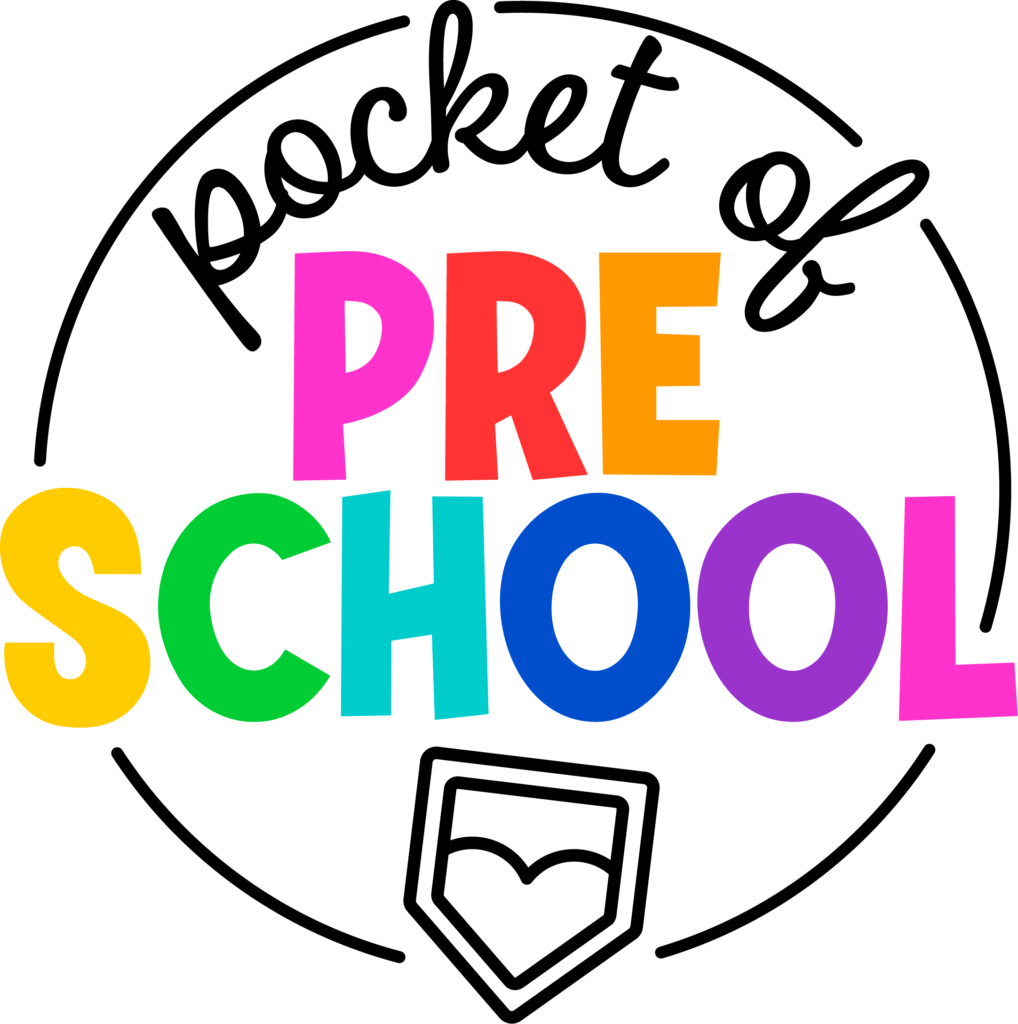
©2023 Pocket of Preschool. All Rights Reserved. Designed by Ashley Hughes
Review Cart
No products in the cart.
Teaching Tips

Dramatic Play
Social Emotional
- Earth Science
- Physics & Engineering
- Science Kits
- Microscopes
- Science Curriculum and Kits
- About Home Science Tools
Teaching Resources & Guides > Science Lessons > Eyes & Vision
Eyes & Vision
Do you know how your vision works?
Read on to find out about the incredible properties of the eye–and how its features affect your vision.
Eyes & Vision Science Lesson
Eye anatomy.
The human eye is one of the the most complex and sophisticated sensory organs in the body.
Its unique automatic focusing system outstrips that of any camera, and its light sensitivity is ten million times greater than the best film designed so far! Before taking a look at how the eye works, let’s start with a basic overview of how it is built.
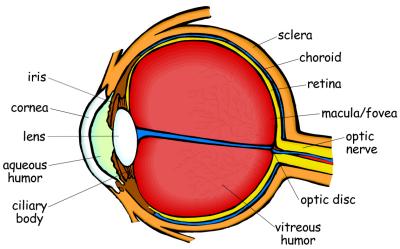
The outside layer of the eye is made up of the sclera and the cornea.
The sclera is the firm white tissue that covers all of the eye except the very front. It helps maintain the shape of the eye and protects the inner parts.
The cornea is the transparent portion at the center front part of the eye that allows light through.
A thin outer mucous membrane called the conjunctiva covers the inside of the eyelids, the cornea, and the front portion of the sclera. It helps lubricate the eye.
The middle layer of the eye contains oxygen- and nutrient-rich blood vessels, most of which are located in the layer of tissue called the choroid .
Near the front of the eye is the ciliary body , a group of muscles and ligaments that attach to the lens. These muscles change the shape of the lens as they relax and contract.
The final component of this layer is the iris , a group of muscles that controls how much light enters the eye by adjusting the opening, or pupil . The iris contains pigments that determine your eye-color.
When you look at a person’s eye, you can see parts from each of the first two layers: the “white” of the eye is the sclera, the front transparent part is the cornea, the iris is the colored part, and the pupil is the dark hole in the center.
The eye’s inner layer is composed of the retina : thin tissue that contains blood vessels and light-sensitive photoreceptor cells called rods and cones.
Every human eye contains about 120 million rods and 7 million cones.
The rods are very sensitive to low-level light, but they cannot distinguish color.
Cones need much more light to function than rods do, but they provide color information and sharp detail.
You may have noticed that in dim light color looks much less vibrant; that is because the rods that help you see in the dark are more or less “color-blind.” The retina also contains a dark pigment called melanin (also found in skin and hair cells) – this reduces reflection of light when it enters your eye.
The blood vessels and the optic nerve (the nerve that conducts electrical impulses to the brain; see the following article to learn more) connect to the retina at a spot called the optic disc .
On this disc there are no rods and cones; this is your blind spot. You don’t usually notice your blind spot, because your two eyes work together to “cover up” each other’s blind spot.
The macula is a small spot in the center of your retina. On this spot is a small pit called the fovea . When light is focused on this spot we get the sharpest image, because the fovea contains very tightly-packed photoreceptor cells. Macular degeneration is a common eye disease that is caused by the deterioration of the macula and results in partial blindness.
The three layers fill only a small part of the eye; the large middle area isn’t empty, though! The area between the cornea and the lens is filled with a transparent liquid material called the aqueous humor. The area between the lens and the retina contains a clear gel-like substance called the vitreous humor. Both of these humors help give shape to the eye and are part of the focusing process.
Your eye is a very delicate organ. The sclera and cornea protect the inner parts of the eye, but there are other protective parts as well.
Most obvious are your eyelids. With the eyelashes , your eyelids help keep outside particles from getting in your eye.
They also help spread tears , which keep the eye moist and wash away anything that gets past the eyelids. Tears are produced in the lacrimal glands and contain antibodies and anti-bacterial enzymes. The tears that your lacrimal glands produce regularly are drained away into the nasal cavity.
When you produce extra tears, though, they will spill out – this is called crying!
How Vision Works
In order to see, your eye must focus light on the retina, convert the light into electrical impulses, and send those impulses to your brain to be interpreted.
It is an amazing and complex process, but you do it constantly without even trying!
Focusing the light. When light bounces off an object and reaches the eye, it must be bent so that its rays arrive at the retina in focus.
Four different surfaces bend the light as it enters the eye: the cornea, the aqueous humor, the lens, and the vitreous humor.
When all four of these bend the light appropriately, you see a focused image of the object.
The eye can focus objects at different distances because the ciliary muscles push and pull to make the lens change shape. When you look at an object that is far away, the ciliary muscles relax and the lens has a flattened shape.
When you look at an object that is close by, the ciliary muscles are contracted and the lens is thickened. This is one of the features that makes the eye superior to any manmade camera.
To adjust a camera lens for the distance of an object, you must move the whole lens forward or back. If our eyes worked the same way, we would need long tubes sticking out of our eyes so the lenses could move back and forth.
Instead, our lenses just change shape to adjust for the distance of an object. This takes up much less room, and is probably more attractive!
In addition to focusing the light, your eye can control how much light gets in.
The colored part of your eye, called the iris, controls the size of the pupil, the opening that lets light through.
In dim light, the iris will cause your pupil to expand, allowing as much light as possible into your eye. In bright light, the iris causes the pupil to contract so that less light can enter.
Converting the light. What happens when the focused light reaches your retina? It triggers a complex chemical reaction in the light-sensitive rod and cone cells.
Rods contain a chemical called rhodopsin , or “visual purple,” and cones contain chemicals called color pigments.
These chemicals undergo a transformation that results in electrical impulses being sent to the brain through the optic nerve.
Interpreting in the brain. When the electrical impulses arrive in the visual cortex of the brain, the brain analyzes the color and light information from the rods and cones and interprets them as light.
The brain flips the image (the light was projected on your retina upside down) and fills in for the blind spot if necessary (read more on this in the science project below).
All this happens almost instantaneously, allowing you to read a book or enjoy a beautiful sunset. Some of the information from the retina is sent to the visual reflex system in your brain. This allows you to react quickly to visual threats.
If you see something coming toward your head, your visual reflex system processes this and causes you to duck before you have time to think about it!
Eyes & Vision Science Projects
Eye chart vision test.
A Snellen eye chart is used to determine how “normal” your vision is. It sets a standard for what most people should be able to see when they stand 20 feet away from the chart.
20/20 vision just means that when you stand 20 feet away from a Snellen eye chart, you see what a normal human being can see.
If you see 20/40, that means that when you stand 20 feet away from the chart, you see what a normal person sees standing 40 feet away from it. The higher the second number, the worse your vision is. 20/200 (you see at 20 feet what a normal person sees at 200) is the number for legal blindness in the United States.
20/20 vision isn’t perfect, it’s just “normal.” You can have better vision than 20/20. If you have 20/10 you see at 20 feet what most people see at 10. Some animals, like hawks, might have 20/2 vision!
You can use our Snellen eye chart * to compare vision within your family or with your friends.
(This will only give you an approximate idea of your vision. Your optometrist has much more precise tools to find out exactly how well you can see.)
Each line of the chart is labeled on the left side. The second to last line is 20/20.
Tape the eye chart to a wall, making sure it is in plenty of light. Stand twenty feet away from the chart and begin reading each line.
Have a family member or friend watch to see that you are reading each letter correctly. The last line that you are able to read will give you an approximate idea of your vision.
If you can read the very bottom line, your vision is 20/10! Now try covering one eye and just testing the other one. Is one eye better than the other?
Have all of your family members try reading the chart. Do some of you have better vision than others? If you wear glasses, what is your vision with them on and what is it without them?
* Instructions for downloading : The Snellen Eye Chart PDF is 11″ x 17″, so to print correctly you will need to set your print options to “tile.” Printer choices will vary, but you should do something similar to this. Open the PDF and choose Print. Under the page scaling options, select “tile all pages.” This should print the chart on four sheets of paper. You will need to trim the edges so the pieces match up, and then tape or glue them together.
(You can also order an already-printed 11″ x 17″ copy of our Snellen Eye Chart.)
Blind Spot Experiments
The spot where your optic nerve connects to your retina is called the optic disc. There are no photoreceptor cells on this disc, so when an image hits that part of your retina, you can’t see it.
This is your blind spot. You don’t notice this blind spot in every-day life, because your two eyes work together to cover it up.
To find it, draw a filled-in, 1/4″-sized square and a circle three or four inches apart on a piece of white paper.

Hold the paper at arm’s length and close your left eye. Focus on the square with your right eye, and slowly move the paper toward you. When the circle reaches your blind spot, it will disappear!
Try again to find the blind spot for your other eye. Close your right eye and focus on the circle with your left eye. Move the paper until the square disappears.
What happened when the circle disappeared? Did you see nothing where the circle had been?
No, when the circle disappeared, you saw a plain white background that matched the rest of the sheet of paper.
This is because your brain “filled in” for the blind spot – your eye didn’t send any information about that part of the paper, so the brain just made the “hole” match the rest.
Try the experiment again on a piece of colored paper. When the circle disappears, the brain will fill in whatever color matches the rest of the paper.
The brain doesn’t just match colored backgrounds. It can also make other changes to what you see. Try drawing two filled-in rectangles side by side with a circle in between them. A few inches to the right of this, draw a square.

Close your right eye and focus your left eye on the square. Move the paper until the circle disappears and the two separated bars become one bar.
How did that happen? The circle in between the bars fell on your blind spot. When it disappeared, the brain filled in for the missing information by connecting the two bars!

Here is one final experiment with your blind spot. In this instance the brain doesn’t match the blind spot with its immediate white background, but instead with the pattern surrounding it.
Draw a line down the center of your page. On one side draw a small square and on the other draw rows of circles. Color the center circle red and all the others blue.
Close your left eye and look at the square with your right eye. As you move the paper, the red circle should disappear and be replaced by a blue one!
Technology: Improving Eyesight
The general design of the human eye is practically flawless – but each individual eye isn’t.
If you are using contacts or glasses to read this article, you know that your eyes aren’t perfect.
Perhaps you are nearsighted and can’t see objects that are far away very well.
Or maybe you are farsighted and have trouble seeing things close-up. Both of these conditions occur because of the shape of the eyeball.
If your eyeball is too short, the light rays will focus the image behind your retina, instead of on it. This produces farsightedness. If your eyeball is too long, the light rays focus the image in front of the retina, making you nearsighted.
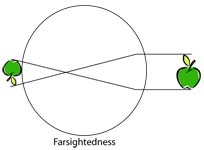
The technology of vision correction has developed over centuries.
The first known eyeglasses were made in the 13th century out of quartz set into bone, metal, or leather.
Eventually the technology for glass-blowing allowed a fine enough quality of glass to be used for lenses.
The biggest problem with these early glasses was keeping them on. It took almost 400 years before someone developed the side arms to rest on the ears!
Most people bought ready-made glasses that would have helped their vision without correcting it precisely.
For example, Benjamin Franklin had two pair of glasses, one for near and one for far. He got tired of changing them, so he cut the lenses in half and repositioned them so that he could see both near and far using the same glasses – the first bifocals!
With the advance of technology, vision-testing equipment has become more and more precise.
Now to obtain a pair of glasses, you must go to an optometrist who will determine exactly what type and strength of lenses you need.
Concave lenses are used for nearsightedness because they bend light away from the center – this stops the light from focusing too far in front of the retina.
Convex lenses are used for farsightedness because they bend light toward the center, causing the light to focus sooner so the image is not focused behind your retina.
Lenses can also be made that will correct other problems in the eye, such as astigmatism , which is an irregular curvature of the cornea.
Contact lenses are a popular alternative to eyeglasses. These lenses fit directly on the cornea, where they “float” on a layer of tears.
They were under experimentation as early as the mid-19th century, though quality and comfort left much to be desired. Now millions of people in the United States use either soft or hard lenses.
Soft contact lenses are made of flexible, water-absorbing plastics. They are more comfortable to wear than hard lenses, which are made of more rigid plastic that does not form to the eye as well. Hard lenses, on the other hand, produce a sharper image.
Some people want a more permanent solution to their vision problems. In recent years, procedures such as LASIK (laser-assisted in-situ keratomileusis) surgery have been developed to remove the need for external lenses like glasses and contacts.
While external lenses change how the light is bent so that it focuses on your retina, laser surgery reshapes the cornea itself.
The process involves a tightly focused beam of ultraviolet light, called an excimer laser. The surgeon first uses a sharp scalpel to cut a flap in the top layer of the cornea, then directs the laser into the middle layer.
As the laser pulses onto this surface, it vaporizes a microscopic portion of the cornea. By controlling the number and location of the pulses, the surgeon controls how much of the cornea is removed.
Noteworthy Scientist: Charles Bell (1774-1842)
Do you ever wonder how great artists can paint a human face that looks perfectly realistic? One of Charles Bell’s contributions to art was an anatomy textbook especially for artists, called Essays on the Anatomy of Expression in Painting .
Charles Bell was an artist himself, as well as a surgeon and anatomist. He was born in Edinburgh, Scotland, the son of a Church of England minister. His older brother John was a surgeon, author, and teacher of anatomy at the University of Edinburgh.
Studying with his brother, Bell developed both his artistic talent and his medical knowledge. After he graduated from the University with a degree in medicine, Bell assisted in teaching his brother’s anatomy class and publishing a four-volume Anatomy textbook.
Eventually Bell moved to London where he did extensive research on nerves, wrote many books and treatises, opened a school of anatomy, and worked as a surgeon.
In 1815 he cared for the wounded after the bloody battle of Waterloo, his skill in surgery holding him in good stead.
His battlefield experience led him to create illustrations of gunshot wounds to be used by surgeons.
Bell’s research on the brain and nerves proved foundational for modern neurology. He determined that nerves only sent information one way: some took sensory information to the brain, and some took commands from the brain to the rest of the body. He also traced nerves from special sensory organs (such as the eye) to specific parts of the brain.
Through all his research and medical illustration, Bell recognized the hand of a Creator. In 1836 he was invited to contribute to a collection of works “On the Power, Wisdom, and Goodness of God as Manifested in the Creation.”
He agreed, and wrote a treatise called The Hand; its Mechanism and Vital Endowment, as Evincing Design .
Bell was knighted by King William IV in 1831, and in 1835 he accepted a position as professor of surgery and returned to Scotland.
He continued to work in his field up until his death in 1842.
More on Eyes & Vision:
- Eyesight for Young Students
- Two Eyes (vs One)
- Cow Eye Dissection
Teaching Homeschool
Welcome! After you finish this article, we invite you to read other articles to assist you in teaching science at home on the Resource Center, which consists of hundreds of free science articles!
Shop for Science Supplies!
Home Science Tools offers a wide variety of science products and kits. Find affordable beakers, dissection supplies, chemicals, microscopes, and everything else you need to teach science for all ages!
Related Articles
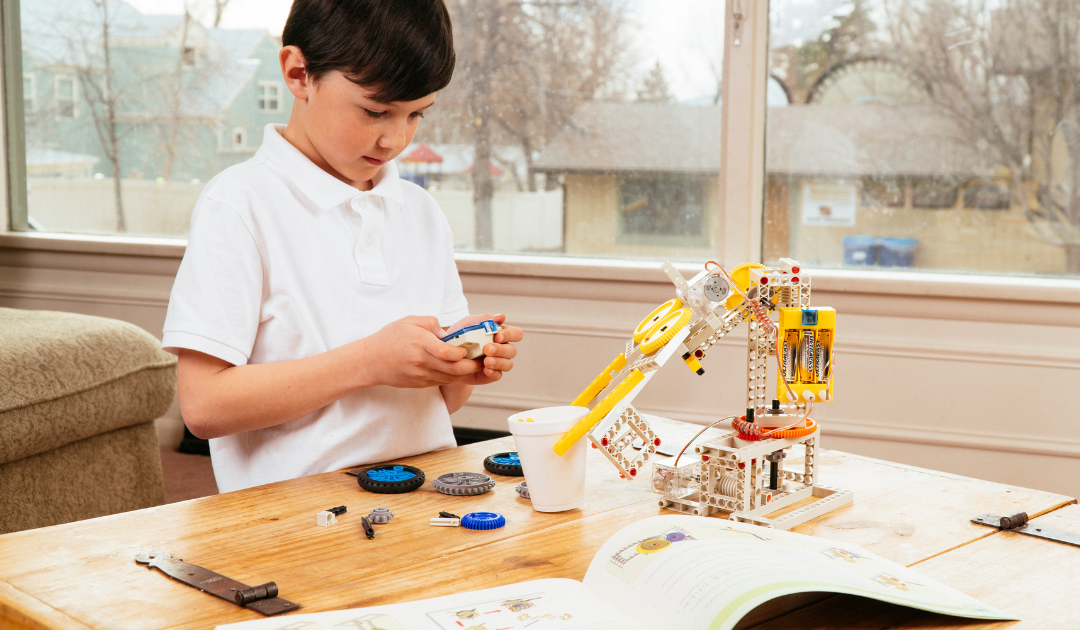
Kids First Early Engineering Kits
A Perfect Blend of Fun and Learning In today’s digital world, finding the right balance between screen time and hands-on learning for kids can be a challenge. That’s why educational toys like Kids First Early Engineering Kits have become a popular choice among...
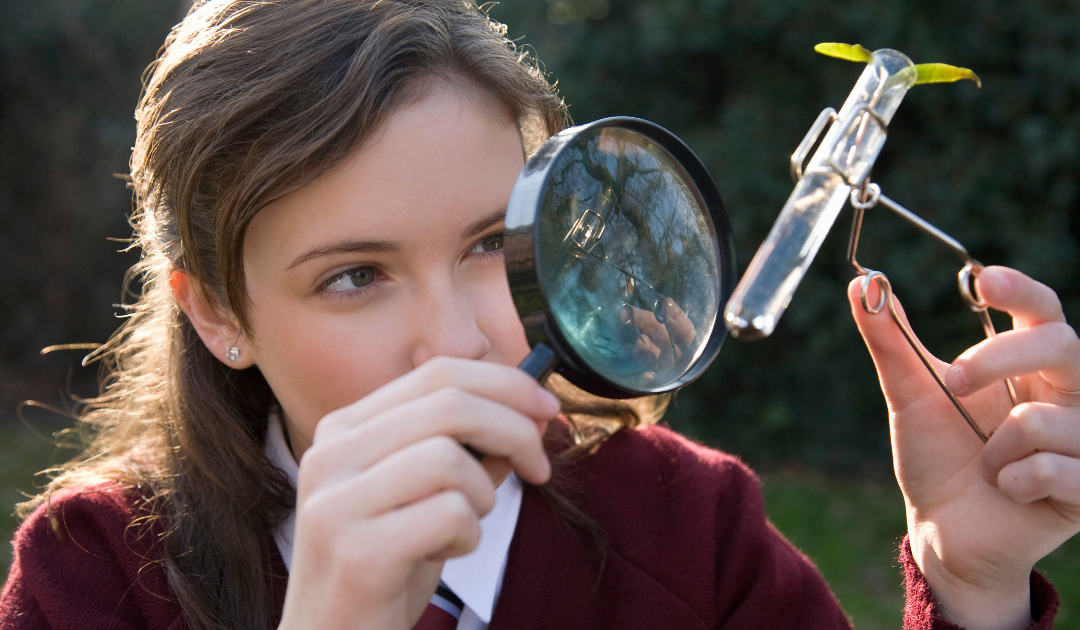
Gift for Biologists
Looking for ideas for gifts that will thrill even the most hard-to-shop-for biologists on your list, whether young or old? (Kids or having a PhD?) We have just the list for you! Read on for favorites (or find top gifts for science lovers of any kind). Biology is...

Cool Gifts for Science Lovers
Looking for the perfect gift for a kid (or adult!) on your list who loves to fiddle with, build, or learn about things? Read on for some cool gifts for any science lovers...whether they actually realize it’s science or not! Browse our best gifts for...

Meet Our HST Alumni
Celebrating Exceptional Learning For 30 years, we've shared our mission to inspire learning through hands-on science with over 1.7 million homeschoolers. Thank you for letting us be your partner in education that goes beyond textbooks or classrooms. Meet three members...
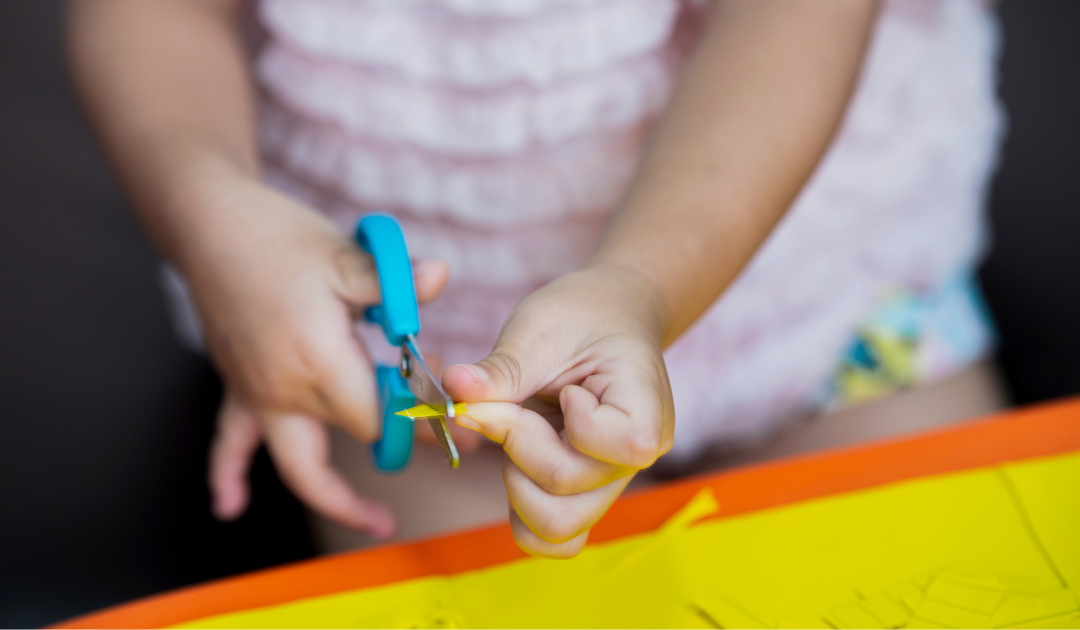
Easy STEM Activities with Paper
Easy STEM Activities with Paper Beneficial STEM activities don't always require expensive materials or fancy equipment–a tool as simple as paper can teach children a range of STEM concepts. In this article, we'll explore STEM activities using paper, from paper...
JOIN OUR COMMUNITY
Get project ideas and special offers delivered to your inbox.

Inventors of Tomorrow
Hands-on science and engineering education for kids age 3 – 6, sight – kids’ science activities.
We studied all five senses in one two hour session. But each one could be a week’s theme in itself. Or if you’re in a homeschool or in a five day a week school setting, you could do one sense per day.
Free Exploration Stations

Light table and Lite Brite: We had a homemade light table (plastic tub with Christmas lights in it) and we put on it colorful plastic cups and clear plastic cups they could decorate with markers for imaginary people play.

Visual gradient : Take 5 – 8 matching test tubes or glasses. Fill with water. Put one drop of food coloring (or liquid watercolor) in the first one, two drops in the second one and so on. Then mix up, and ask kids to re-sort them in order from lightest to darkest.

How does using your sense of sight help you use your other senses ? On our five senses day, we also had some exercises of: can you recognize this taste without looking at what you’re tasting? Can you recognize the smell without looking in the container to see the item? Can you recognize a sound in a shaker without opening it to look?
Art projects
Thaumatropes : A thaumatrope is a Victorian toy, where there are two images on two sides of a card. It is mounted on a string (like a button spinner ) or on a straw and when it spins, showing first one side, then the next, they seem to spin together to create a single image. This is due to persistence of vision . Instructions here: https://inventorsoftomorrow.com/2021/03/17/thaumatropes/
Spy glasses : We made some “binoculars” with toilet paper tubes, where we taped two tubes together, added strings for hanging them around our necks on the hike and decorated them. We also used just toilet paper tubes. We went for a hike in the woods. When you look at the world through a focused tube, it focuses your attention very differently, and you see things in a very different light than normal. (Really, adults… try this! It’s intriguing how it changes the details you see.)
Kaleidoscopes : We made kaleidoscopes by taking paper towel tubes, wrapping in wrapping paper (to make them prettier – optional). Then we took Dixie cups we’d cut the bottom off of so you could look through them. We taped saran wrap over one end, filled with some decorative stones, then taped saran wrap over the other end, then taped the cup onto the end of the tube. (Sorry I didn’t get a picture of a final product!)
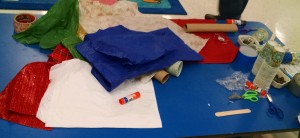
Ways to improve this project for the future: I think it would have worked better to use the small plastic dip containers with lids rather than Dixie cups. They would have been sturdier and held items better than the saran wrap did. Also, I think lightweight confetti type items would be better than the heavy glass stones. (Note: if you want to make a more sophisticated kaleidoscope with a triangular mirror in the center to reflect the items, see Inna’s Creations’ post and minieco.co.uk )
Guided Activity
Camouflage : We hid plastic dinosaurs in the woods. We were careful to hide the yellow ones near yellow fallen leaves, the green amongst holly and salal, and we hid the velociraptor – the one with stripes on its back under the sword fern.
On our hike, we reminded them of last week’s discussion of habitats . We explained how another way animals adapt to their habitats is they develop similar coloring to their surrounding so they’re harder to spot. We asked questions like “Can you see a polar bear in the snow? How about a giraffe? Could you see a giraffe in the snow? Where would be a better place for a giraffe to hide?” Then, we had them seek out the dinosaurs. They were surprisingly well hidden! Even the adults who hid them had a hard time finding them all! (Hint: make sure you count how many you put out, and take a picture of them! We’d found nine out of ten and I couldn’t even remember which one was missing till I looked at the picture. Then I showed the picture to the kids and then they found the velociraptor under the sword fern.)

What if your sense of sight didn’t work ? There are lots of things you could do to explore this question with children. Turn off the lights, or blindfold them. Then:
- Play “listening tag”. Put the blindfolded child in the middle of a circle. Ask the other children to be quiet. When you point at a child, they talk. The one in the middle points to where they think the talking person is. Then point to another child, and so on.
- Play “wet rag on a stick.” If it’s a hot summer day, it’s hard to beat the loud, wet fun of this game. Make a circle of kids holding hands. Put a child in the middle with a blindfold. Give them a stick and then hang a sopping wet washcloth off the end of it. The circle of kids circles around the child shouting, calling their name, taunting (nicely). Then the child decides who to try to nail with the rag, and when ready, flings it. If they miss (or the kids dodge) they keep the blindfold on. If they hit, the kid who got hit is now it. (And is now sopping wet….)
- Let them explore a safe obstacle course.
- Have another child lead them around a room or outdoors.
- Have them touch common objects and see if they can identify what they are touching. Or play instruments/noisemakers and see if they can identify what you’re using. Or have them smell things. Or taste things… All these things will illustrate how we use all our senses together to create a more nuanced view of what we’re experiencing.
- Where’s Waldo books or I Spy books give children a chance to practice spying things and looking at details closely.
- There are LOTS of books on the 5 Senses. I review them all here .
Sight day could be a great day to bring in some rainbow activities or have fun with light and shadow . For lots more ideas, including optical illusions, look here .
Watch this video on How Animals See the World Differently than humans.
Share this:
- Click to share on Facebook (Opens in new window)
- Click to share on Twitter (Opens in new window)
- Click to share on Pinterest (Opens in new window)
- Click to print (Opens in new window)
- Click to email a link to a friend (Opens in new window)
[…] Sight – Kids’ Science Activities […]
[…] Five Senses Unit: Overview, Hearing, Vision, Touch, Taste, Smell […]
[…] a thaumatrope (for little kids) or a flip book (for kids 7 and up). Both are ways of “animating” a […]
[…] two sides of a card, then spin it fast – it looks like the drawings merge. We make these in Five Senses week. You can also make them button-spinner […]
[…] Make a thaumatrope: Kind of like a flip book, but much less work! Make two drawings – and then tape them back to back on a straw, pencil, or dowel. When you roll it back and forth in your hands, the drawings blend together. […]
[…] have used plastic straws for our thaumatropes and our sundials. I could substitute dowels or pencils in both those projects, though I’ll […]
Leave a comment Cancel reply

- Already have a WordPress.com account? Log in now.
- Subscribe Subscribed
- Copy shortlink
- Report this content
- View post in Reader
- Manage subscriptions
- Collapse this bar

IMAGES
VIDEO
COMMENTS
Eardrum Experiment. You’ll need: Stretch the plastic wrap over the bowl tightly. This is your eardrum. Place 20 or so rice grains on the tightened plastic wrap. Hold the pan or cookie sheet close to the blow, but not touching. Bang on the pan with your hand or large spoon making a loud noise. Watch the rice.
October 5, 2018. 3 min read. by ItsySparks. Mini Scientists. In studying about our Fives Senses, we have enjoyed exploring our sense of touch, hearing, and taste. Our most recent exploration has been with our sense of sight. We rely very much on our sight to move around and see things every day. Our eyes are very complex in how they work.
Eye Science Experiments. Children will have fun learning about how their eyes work with this easy science project exploring their sense of sight! This Eye Science Experiments is such a fun addition to a lesson on my body for preschoolers, kindergartners, grade 1, grade 2, grade 3, grade 4, grade 5, and grade 6 students. Plus you will appreciate ...
The 5 Senses. As humans, we have five tools that help us explore the world around us – sight, hearing, smell, taste, and touch. Our eyes, ears, nose, mouth, and skin gather a lot of information about the world; they help protect us and help us enjoy life! Not everyone is born with all of these senses.
Here are 11 simple ideas. 1. Read & Discuss: Arlo Needs Glasses. Arlo Needs Glasses by Barney Saltzberg is an interactive picture book that introduces the practical topics of eye checkups and getting glasses to help with sight when needed. Children who wear glasses can share their experiences.
Introduce your 5 senses unit with a popcorn experiment! Kids love popcorn, and it hits all the senses in this fun, interactive experiment. Students taste, touch, smell, see, and hear the popcorn while learning about their 5 senses. This could also be a great way to end your 5 senses unit for a hands-on recap.
Activity 1. Standing several feet away from your child, toss a bean bag back and forth (or two kids can do it together). After a few tosses, blindfold your child (or children) and yourself. Then try tossing the bean bag back and forth again. Talk about what senses you had to use when your eyes were covered and what was harder to do when you ...
Scientific Method. This is an interesting experiment that explores certain aspects of how your brain pays attention. In this project, you'll have to recruit a bunch of volunteers to take a simple test: naming a list of printed shapes. What makes the test tricky is that words will be printed on top of the shapes.
To find it, draw a filled-in, 1/4″-sized square and a circle three or four inches apart on a piece of white paper. Hold the paper at arm’s length and close your left eye. Focus on the square with your right eye, and slowly move the paper toward you. When the circle reaches your blind spot, it will disappear!
There are LOTS of books on the 5 Senses. I review them all here. More ideas. Sight day could be a great day to bring in some rainbow activities or have fun with light and shadow. For lots more ideas, including optical illusions, look here. Watch this video on How Animals See the World Differently than humans.